
Qu'Appelle, Saskatchewan
Encyclopedia
Qu'Appelle, Saskatchewan, is a small village (legally, for historical reasons, a town
) and formerly in ecclesiastical terms a city, with considerable historic significance located on Trans-Canada Highway
and the Canadian Pacific Railway
(CPR) mainline, some 30 miles (48.3 km) east of the provincial capital of Regina
.
Qu'Appelle was for a time the terminus of the Canadian Pacific Railway
and the major distribution centre for what was then the District of Assiniboia in the North-West Territories and is now southern Saskatchewan. The town is situated in a lush rolling parkland, with intermittent coulee
s containing steady-flowing creeks running into the Qu'Appelle Valley, poplar bluffs
and sloughs.
Qu'Appelle had at one stage been credibly anticipated to be the major metropole
of the North-West Territories by both the federal government
and the Church of England (now the Anglican Church of Canada
). It was under serious consideration by the federal government as district headquarters of the District of Assiniboia and territorial headquarters of the North-West Territories
. The Church of England had in anticipation of Qu'Appelle's future urban importance designated it the cathedral city for the Diocese of Qu'Appelle, which geographically corresponded precisely to the District of Assiniboia in the North-West Territories.
Political events, however, passed Qu'Appelle entirely by when Lieutenant-Governor
Edgar Dewdney
selected the locale of his own landholdings at Pile-O-Bones
(then re-named "Regina") as his Territorial capital: Qu'Appelle's significance other than in historical terms then largely lapsed.
 The CPR
The CPR
arrived in 1882-83, and the post office was founded at what was originally called Troy on August 1, 1882. For a time Qu'Appelle appeared likely to be the administrative headquarters for the District of Assiniboia, which corresponded to the southern portion of the present day province of Saskatchewan.
Two versions of the origin of the name "Troy" are proposed: That
(1) it was named after Troy, Ontario by Wellington Mulholland, a land surveyor and land agent and
(2) the name was chosen by the brothers Stephen and James Caswell who were merchants in the area and managed the post office.
Original settlers hung onto the old name of "Troy" well into the 20th century.
 When the Canadian Pacific Railway
When the Canadian Pacific Railway
arrived in 1884 the new town was renamed Qu'Appelle Station in reference to the nearby Qu'Appelle Valley, which was the location of a long-established Hudson's Bay Company
factory. The name "Qu'Appelle," a corruption of qui appelle, French for "Who calls?" refers to the once-popular legend of the Qu'Appelle Valley popularly versified by E. Pauline Johnson.
In 1902 the name was changed to South Qu'Appelle and in 1911 the longstanding confusion as to the name "Qu'Appelle," which also referred to the former Hudson's Bay Company
fort town in the Qu'Appelle Valley, to the northeast of Qu'Appelle, was resolved when the two communities agreed to deem the then-CPR
station site as Qu'Appelle and the town in the valley as Fort Qu'Appelle.
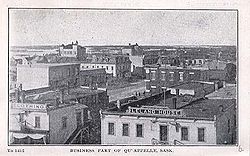 Like many small Canadian prairie towns, Qu'Appelle has had a considerably livelier past than its present. A Hudson's Bay Company
Like many small Canadian prairie towns, Qu'Appelle has had a considerably livelier past than its present. A Hudson's Bay Company
trading temporarily stood southwest of the future site of the town from 1854 through 1864 when it was re-located back to its previous site, the modern Fort Qu'Appelle
in the Qu'Appelle Valley.
Qu'Appelle was at one point among the likely choices as capital of the North-West Territories, as indicated by its original status as the historical see city of the Anglican Diocese of Qu'Appelle. The choice of Pile-of-Bones, as Regina was originally called, as the Territorial headquarters was a national scandal in the 1880s: there was an "obvious conflict of interest" in Lieutenant-Governor Edgar Dewdney
's promoting of Pile-of-Bones as the territorial headquarters. A 1980 local town history reports that
Until 1897, however, when responsible government
was accomplished in the Territories, the lieutenant-governor and council governed by fiat and there was little legitimate means of challenging such decisions outside the federal capital of Ottawa
, where the Territories were remote and of little concern.
 Qu'Appelle attained national prominence in 1885 during the North-West Rebellion
Qu'Appelle attained national prominence in 1885 during the North-West Rebellion
. Until the construction of the Qu’Appelle, Long Lake, and Saskatchewan Railway in 1890 linked the newly-established Regina with Saskatoon and Prince Albert, Qu'Appelle was the major debarkation and distribution centre for the North-West Territories.
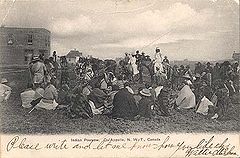 General Frederick Dobson Middleton
General Frederick Dobson Middleton
, who billeted in Qu'Appelle's Queen's Hotel (which survived into the 21st century), made Qu'Appelle the marshalling point to the locus of the North-West Rebellion
(the Saskatchewan or Second Riel Rebellion) in the north-west for troops arriving by train from eastern Canada. For some years Qu'Appelle was the centre of national attention as journalists based there reported back home to eastern Canada on developments in the Saskatchewan Rebellion.
The resolution of the Saskatchewan Rebellion perhaps needless to say did not comprehensively resolve conflicts among settlers and aboriginal people. Many Qu'Appelle children of the late 19th and early 20th centuries recounted frightening encounters with angry Cree and Métis, who not unreasonably bore a considerable grudge against white settlers in the Qu'Appelle region..
As in Fort Qu'Appelle
, town life in many ways resembled that of an Indian hill station during the British Raj. Perhaps improbably in so small a community but indicative of the not always tolerant and inclusive social mores of early settlement in the Canadian west, discrete neighbourhoods of Qu'Appelle were called "Germantown" and "Breedville," the latter in racist early reference to the prairie Anglo-Métis
, whom white settlers at the time called "half-breeds," a term now considered disparaging, and generally avoided.
 Relations between the English immigrants of the Anglican pro-cathedral parish and the native-born Canadian Presbyterian, Methodist and Roman Catholic settlers from Ontario and Quebec were at times frosty and the Anglican Church was long referred to in some disparagement as "the English Church" by eastern Canadian settlers who perhaps regarded themselves as more authentically Canadian. At one point Bishop Harding, the Church of England (Anglican) bishop, was quoted at a meeting — when he was imprudently unaware that local Canadians were hearing his remarks — as observing that English Anglican migrants might be more attractive settlers than Presbyterian and Methodist Canadians, occasioning considerable adverse notice and animosity against the English in the general community.
Relations between the English immigrants of the Anglican pro-cathedral parish and the native-born Canadian Presbyterian, Methodist and Roman Catholic settlers from Ontario and Quebec were at times frosty and the Anglican Church was long referred to in some disparagement as "the English Church" by eastern Canadian settlers who perhaps regarded themselves as more authentically Canadian. At one point Bishop Harding, the Church of England (Anglican) bishop, was quoted at a meeting — when he was imprudently unaware that local Canadians were hearing his remarks — as observing that English Anglican migrants might be more attractive settlers than Presbyterian and Methodist Canadians, occasioning considerable adverse notice and animosity against the English in the general community.
The fine yellow brick town hall and "opera house" remains marginally in use, though its auditorium has long since been closed to public use because it falls short of modern standards of safety and the town cannot bring it up. Its companion building, Qu'Appelle High School, built in similar style in identical yellow brick, closed in 1973 and was demolished in 1975. The Queen's Hotel, built in 1884, survived, latterly largely as a town pub, until its destruction by fire in 2003.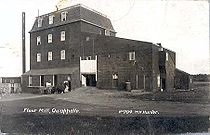 The first Qu'Appelle businesses of 1882 were a restaurant operated by J. Stoddard; pool hall by Love & Raymond; livery and feed store by Johnston & Paterson; livery and feed store by Joe Doolittle; and harness shop by John Milliken. An observatory was opened in 1882 by Leslie Gordon and provided morning and evening weather readings for the CPR
The first Qu'Appelle businesses of 1882 were a restaurant operated by J. Stoddard; pool hall by Love & Raymond; livery and feed store by Johnston & Paterson; livery and feed store by Joe Doolittle; and harness shop by John Milliken. An observatory was opened in 1882 by Leslie Gordon and provided morning and evening weather readings for the CPR
until 1907, when the observatory was supplemented with anemometer and weather recording devices.. observatory The Qu'Appelle Felt and Boot factory opened at the end of 1897 but liquidated in 1900.. A fire in 1883 destroyed much of the new business district but soon there were six stores, three hotels, five implement agencies, two butcher shops, a flour and feed store and a bakery.
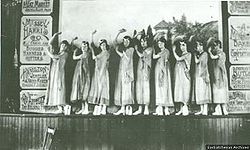 Well into the twentieth century there was still a train station, some half-dozen grain elevators, a bank, post office, butcher, two general stores, a hardware store, pharmacy, the hotel (and "beverage room," in the terminology of the early 20th century Canadian West, though closed from 1915 to 1925 under Premier Walter Scott
Well into the twentieth century there was still a train station, some half-dozen grain elevators, a bank, post office, butcher, two general stores, a hardware store, pharmacy, the hotel (and "beverage room," in the terminology of the early 20th century Canadian West, though closed from 1915 to 1925 under Premier Walter Scott
's prohibition and temperance legislation), barber shop, firehall, law office, numerous service stations, several cafés, cinema (later converted to a grocery store, also now closed) and a covered rink. In the 1890s, there was "a flour mill, a creamery [and] a felt and boot factory."
The Qu'Appelle Anglican Diocese maintained the St John's College Farm immediately to the west of town. By 1910 the town's population had risen to nearly 1,000. Qu'Appelle was an important local business, shopping and distribution centre which, staged an annual summer fair.
 Unlike in parts of the North-West Territories and, then, Province of Saskatchewan settled by Eastern Europeans in the Laurier
Unlike in parts of the North-West Territories and, then, Province of Saskatchewan settled by Eastern Europeans in the Laurier
-Sifton
migration of the last decade of the nineteenth century and first decade of the twentieth, much of the settlement in the Qu'Appelle District was by well-capitalised eastern Canadians and Britons. Rather than the small sod and plain lumber houses and outbuildings of later homesteaders, farm as well as town residential and outbuilding construction here was frequently large, ostentatious and built of brick or stone, often with large formal gardens, indicating not only the large families of the time but the anticipation of considerable prosperity and the ability to employ domestic help.
Town amenities of the early decades of settlement were contingent on the farming hinterland being far more densely populated than today; travel to Regina was accomplished via a train journey and domestic transport mostly by horse drawn conveyances. With the vastly depleted rural population and improved transport these amenities have almost wholly lapsed. The rationalisation by the grain companies of their depots for buying grain from farmers and the resulting disappearance of Qu'Appelle's grain elevators hastened the process of decline as even the regular visits by farmers to town to deliver grain ceased.
, there were also large farming ventures near Qu'Appelle. W. Thistle and Thomas Wright started the Wright farm in 1882 on four sections
of land (one section having been one square mile, 640 acres or 2.6 km²). By 1884, there were 770 acres (3.1 km²) in crops and 1050 acres (4.2 km²) tilled and ready for seed.
32,000 for farm equipment to establish the W.R. Sykes English Company farm. ($32,000 is equivalent to $ in present day terms.) W.R. Sykes purchased eighteen sections of land north of Qu'Appelle and brought in the first first steam plows to Western Canada. An advertisement featuring the Lord Brassey farm and estate was run in England and attracted farmers to the Church Colonisation Society venture called the Christ Church Settlement. In the 4¾ sections bought by the Church Colonisation Society 40 acres (16.2 ha) were set aside for each family. Amongst initial setbacks, the major blow came when the Dominion Land Survey
offered 160 acres (64.7 ha) to settlers, making the 40 acres (161,874.4 m²) a mere pittance in comparison.. In 1885 #1 hard wheat was selling for $0.62 a bushel.. As a comparison to these large farms, the average homesteader on his single quarter section of land could barely afford a team of oxen which in 1882 cost around $250. At the time a good team of horses would run about $600.. ($250 is equivalent to $ in present day terms and $600 is equivalent to $ )
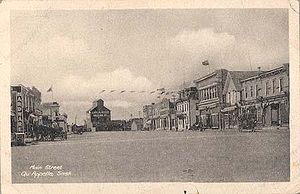
, later Regina, as his Territorial Capital was only the first of the disasters to befall Qu'Appelle. The opening of the Qu'Appelle, Long Lake and Saskatchewan Railway in 1890, which linked linked Regina, Saskatoon and Prince Albert, ended Qu'Appelle's important role as a distribution centre. Bishop Burn's closing of the Qu'Appelle Model Farm and transfer of Bishop's Court (the bishop's "palace") from Qu'Appelle to Indian Head
in 1895 accelerated the decline. Thereafter Qu'Appelle's pretensions as the would-be metropole for the District of Assiniboia were comprehensively dispelled.
status, which was then conferred on St Paul's Regina
.
 By the immediate post-War period the rationalising of prairie dryland farming practices and the depletion of the rural population — as throughout the Canadian prairies — was further accelerating Qu'Appelle's decline. The CPR Railway station, the grain elevators, the Post Office, the Royal Bank of Canada, the Red and White grocery store, the Hamblin general store, the barber shop and four gas stations remained (albeit that two of them were Esso
By the immediate post-War period the rationalising of prairie dryland farming practices and the depletion of the rural population — as throughout the Canadian prairies — was further accelerating Qu'Appelle's decline. The CPR Railway station, the grain elevators, the Post Office, the Royal Bank of Canada, the Red and White grocery store, the Hamblin general store, the barber shop and four gas stations remained (albeit that two of them were Esso
and Royalite
stations on the now-relocated trans-Canada highway to the south of the town). These were not to last beyond 1970.
The upgrading of the trans-Canada highway
in the immediate post-World War II years with the highway being re-routed to the south took east-west traffic outside the town; the CPR continued to provide passenger and freight services only briefly after the War as private auto ownership became normative, and freight transport increasingly was delegated from the railways to highway trucking, and Qu'Appelle CPR station eventually closed and was demolished.
The long-disused movie theatre building on Main Street across the street from the Kraus BA
garage briefly was turned into a general store in the 1960s when Hamblin's General Store and the Red & White Store closed but this soon ended. The bypassing of Qu'Appelle by Highway 10
to the Qu'Appelle Valley, the closing of the grain elevators and the gas stations, the high school and all the remaining grocery stores determinatively spelled the end of Qu'Appelle as a viable commercial centre.
 Until the 1940s the trans-Canada highway passed through Qu'Appelle — it was then relocated some half-mile to the south — and till the 1960s Qu'Appelle commerce was marginally saved from moribundity by local farmers bringing their grain to sell in the several now-demolished grain elevators and by Regina cottagers passing through en route to the Qu'Appelle Valley when the Trans-Canada Highway to Qu'Appelle and then Highway 35 north to the Valley was the only convenient route. This ended in 1968 when the Highway No. 10
Until the 1940s the trans-Canada highway passed through Qu'Appelle — it was then relocated some half-mile to the south — and till the 1960s Qu'Appelle commerce was marginally saved from moribundity by local farmers bringing their grain to sell in the several now-demolished grain elevators and by Regina cottagers passing through en route to the Qu'Appelle Valley when the Trans-Canada Highway to Qu'Appelle and then Highway 35 north to the Valley was the only convenient route. This ended in 1968 when the Highway No. 10
cut across directly from Balgonie
to the Valley. In recent years Qu'Appelle has enjoyed a mild resurgence as a result of commuters from Regina discovering it as a bedroom community, but local commerce has never recovered and there are no longer any retail outlets, service stations, banks, barbers or beauty parlours or a post office in the town.
To encourage population growth, the town council for a time advertised lots for sale at one dollar as a means of attracting new residents, and several mobile homes in town are the result. According to the Encyclopedia of Saskatchewan "about 80% to 90% of the town’s workforce drives to and from the city each day" With the resulting dearth of local commerce the once solidly built up main street is now almost entirely lined with vacant lots and abandoned buildings. A succession of fires from the 1950s through the 2000s comprehensively removed wooden historic commercial buildings from Main Street.
 As late as the 1960s there were still a hospital, post office, butcher, Red & White grocery store, general store, barbershop and several garages, including Royalite
As late as the 1960s there were still a hospital, post office, butcher, Red & White grocery store, general store, barbershop and several garages, including Royalite
and BA
stations on the trans-Canada highway
and two garages in town operated by the Kuntz and Kraus families. The historic Queen's Hotel, built in 1884 and perhaps the last of the major commercial structures of Main Street, burned to the ground in 2003.
James Hamblin School, the town primary school built in the 1960s and named for the proprietor of the long-operating (but now long-defunct) Main Street general store, remains in operation with nine staff and an enrolment of 156 in 2007. The Saskatchewan library association maintains a travelling library in the Town Hall with internet access to the province-wide collection and provides facilities for ordering books from such collection. This is in contrast with the otherwise sadly depleted resources of today's Qu'Appelle by comparison with the burgeoning community of the past.
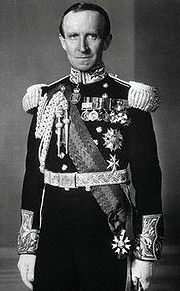 During the Great Depression
During the Great Depression
Susan Buchan (Lady Tweedsmuir), Vicereine of Canada and wife of John Buchan (Lord Tweedsmuir)
, the then-eminent novelist who was Governor General of Canada, established a library project by which used books were collected in Eastern Canada and distributed by the train carload throughout western Canada free of charge so long as local persons would pick up the freight charge.
Assorted Qu'Appelle persons were able to do so. Qu'Appelle library in the Town Hall and the rural schools of the Qu'Appelle District accumulated libraries through Lady Tweedsmuir's project when local patrons were able to pay the freight; the 1940s, 50s and 60s rural schools and indeed farm houses still had libraries remaining from her project.
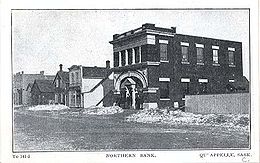 Qu'Appelle today need no longer depend on such a provident society charitable facility as the provincial library service maintains a library in the town hall. The long-disused movie theatre on Main Street across the street from the former Kraus Esso
Qu'Appelle today need no longer depend on such a provident society charitable facility as the provincial library service maintains a library in the town hall. The long-disused movie theatre on Main Street across the street from the former Kraus Esso
service station briefly enjoyed a second life as a general store during the 1960s when James Hamblin's general store closed on his death but it lasted only for a decade.
The Qu'Appelle Royal Bank of Canada
branch, built in 1906 by the Northern Bank and taken over by the Royal Bank of Canada in 1925, is located on the east side of Main Street. The branch continued to operate until the 1960s when reduced commercial activity in Qu'Appelle and declining population in the hinterland made it no longer viable. The building is now in use as a commercial laboratory.
At present there remains a small business core, gas station, grocery store, butcher shop, insurance agency, post office, two restaurants, bar, greenhouses, transport grain storage, hair dresser, a print shop, tattoo parlour and analytical laboratory. The Odd Fellows, a local service club, is long dissolved. There still remains a Masons lodge, a Lions Club, the Community Players and a Historical Society. Skating rink, baseball diamonds, with a nearby indoor horseback riding arenas, elementary school and RM office.
 The "Opera House" — the auditorium in the Town Hall — is long closed and remains unused, having failed to conform to contemporary safety regulations. The disused former Red & White grocery store on main street, one of the few buildings still standing, is now converted to use as a community hall in default of the Town Hall auditorium's continuing utility.
The "Opera House" — the auditorium in the Town Hall — is long closed and remains unused, having failed to conform to contemporary safety regulations. The disused former Red & White grocery store on main street, one of the few buildings still standing, is now converted to use as a community hall in default of the Town Hall auditorium's continuing utility.
By the 1960s many farmers were working in winter in "town" — not Qu'Appelle, whose commercial vitality had by now entirely lapsed, but certainly Fort Qu'Appelle and indeed Regina — and winter social activities in the former rural communities had entirely lapsed. Farming had become a part-time summer job for farmers, who previously would have regarded farming as their principal occupation and wintertime jobs as a distraction.
The availability of unlimited water on farmsteads became an issue when the Government of Saskatchewan at length permitted the subdivision of farmsteads: when this became viable, numerous luxurious farmsteads became attractive venues for townspeople to set up summer homes on former Qu'Appelle district farmsteads with the former farms consolidated as large-scale commercial operations having no relationship whatever with their former farmsteads.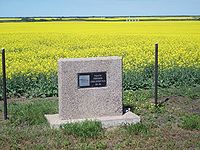 However, the rural population which Qu'Appelle had served steadily declined as family farms were consolidated: The Dominion Lands Act, 1872 had provided for farms of 160 acres (64.7 ha) or ¼ section, a section being one square mile (2.5 km2). The Depression of the 1930s made it clear that while this might have been enough land for a family farm in eastern Canada
However, the rural population which Qu'Appelle had served steadily declined as family farms were consolidated: The Dominion Lands Act, 1872 had provided for farms of 160 acres (64.7 ha) or ¼ section, a section being one square mile (2.5 km2). The Depression of the 1930s made it clear that while this might have been enough land for a family farm in eastern Canada
, it was not nearly enough in the dryland farming conditions of the prairies, and farmers steadily sold up or bought up, farm sizes increased and the hinterland population waned.
Rural churches
, largely Presbyterian and then as of 1925 United Church, served by ministers based in Qu'Appelle, Indian Head and Fort Qu'Appelle, and rural one-room schools
closed by the late 1950s and early 1960s respectively: all rural churches were gone by 1960 and the remaining rural schools were closed in June, 1963; farm children were thereafter bused to town school. Little trace of either now remains as rural schools' and churches' property was resumed by local farmers.
 Qu'Appelle is located in the Indian Head Plain of the Aspen Parkland ecoregion on the parkland of the Qu'Appelle flood plain. Qu'Appelle's elevation is 662.9 m (2,174.9 ft) above sea level
Qu'Appelle is located in the Indian Head Plain of the Aspen Parkland ecoregion on the parkland of the Qu'Appelle flood plain. Qu'Appelle's elevation is 662.9 m (2,174.9 ft) above sea level
. The area is characterised by lush rolling grasslands, interspersed with poplar
bluffs (in prairie Canadian terminology poplar groves surrounding sloughs) and open sloughs. Qu'Appelle is located in the transition zone between the Qu'Appelle River and the corresponding Qu'Appelle Valley and the Canadian Prairies
.
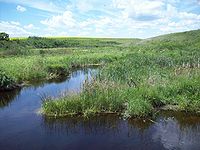 Echo Creek (occasionally known as Springbrook Creek) rises immediately to the north of Qu'Appelle and opens out into a broad coulee immediately to the south of the Qu'Appelle Valley. In the past it ran dry by late summer; global warming or other factors have caused it to run freely throughout the summer and to have fish swimming freely in it till the fall freeze-up. Beavers occasionally dam the creek in the spring using the poplars that line its coulee; at various points it opens up into ponds where in the past when the Qu'Appelle region was amply populated farm children swam.
Echo Creek (occasionally known as Springbrook Creek) rises immediately to the north of Qu'Appelle and opens out into a broad coulee immediately to the south of the Qu'Appelle Valley. In the past it ran dry by late summer; global warming or other factors have caused it to run freely throughout the summer and to have fish swimming freely in it till the fall freeze-up. Beavers occasionally dam the creek in the spring using the poplars that line its coulee; at various points it opens up into ponds where in the past when the Qu'Appelle region was amply populated farm children swam.
Natural features of Egg Lake (20.6 km (13 mi)); Echo Creek (14.8 km (9 mi)); the Fishing Lakes
(25.1 km (16 mi)) and Strawberry Lakes (27.7 km (17 mi)) are near Qu'Appelle. The Fishing Lakes—Katepwa, Mission, Echo and Pasqua Lakes—immediately to the north of the Qu'Appelle in the Qu'Appelle Valley, are all fed by the Qu'Appelle River.
The Indian Head Bird Sanctuary, maintained by the Canada Agriculture Experimental Farm Tree Nursery is located 14 km (9 mi) east of Qu'Appelle. The sanctuary is a mixed-grass prairie eco-region and wetlands created by the damming of the Indian Head Creek.
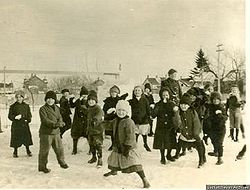 Qu'Appelle has a semi-arid
Qu'Appelle has a semi-arid
, highland continental climate
with dry winters and cool summers (Koppen climate classification
BSk, Qu'Appelle's winters can be uncomfortably cold; but warm, dry Chinook wind
s routinely blow into the city from the Pacific Ocean
during the winter months, providing the occasional break from the cold especially during the times of El Niño-Southern Oscillation
. These winds have been known to raise the winter temperature by up to 15 C-change in just a few hours.
Qu'Appelle is a town of extremes, and temperatures have ranged anywhere from a record low of -42 C in 1983 to a record high of 38.5 °C (101.3 °F) in 1988. According to Environment Canada
, the average temperature in Qu'Appelle ranges from a January daily average of -15.5 C to a July daily average of 18.3 °C (64.9 °F).
As a consequence of Qu'Appelle's relative dryness, summer evenings can be very cool, the average summer minimum temperature drops to 10.6 °C (51.1 °F). Qu'Appelle has a semi-arid
climate typical of other cities in the Western Great Plains
and Canadian Prairies.
Qu'Appelle receives an average of 452.5 mm (17.81 in) of precipitation annually, with 340.6 mm (13.41 in) of that occurring in the form of rain, and the remaining 111.9 mm of precipitation as 111.9 cm (44.1 in) of snow. Most of the precipitation occurs from May to August, with June and July averaging the most monthly rainfall. On 13 July 1981, Qu'Appelle received 113.1 mm (4.45 in) of precipitation, making it the wettest day in the town's recorded history
. On 12 May 1983, Qu'Appelle received 45 cm (18 in) of snowfall, providing the snowiest day in the town's recorded history
. Droughts are not uncommon and may occur at any time of the year, lasting sometimes for months or even several years.
data estimates the town's population at 624 residents, continuing a trend of population decline in the town since the 2001 Census
. Of this population, 48.8 per cent were male and 51.2 per cent were female. Children under five accounted for approximately 4.8 per cent of the resident population of Qu'Appelle.
Between 2001 and 2006, Qu'Appelle's population decreased by 3.7 percent. During the same time period, the population of Saskatchewan
decreased by 1.1 percent, while that of Canada grew by 5.4 percent. The population density of Qu'Appelle averaged 147.7 PD/km2, compared with an average of 1.6 /km2 for the province. According to data from 2001 (although with so small a population percentages are not especially informative) more than 36.9% of the town's residents identify themselves as Roman Catholic; 38.46% of residents are Protestant, 2.3% are undifferentiated Christian, 5.38% are Buddhist, and 16.9% of residents do not practise a religion.
Qu'Appelle is a part of Census Division No. 6
. Qu'Appelle and area do not belong to a Saskatchewan Regional Economic Development Authority, REDA.
According to the Canada 2001 Census
the community profile was as follows:
 The Qu'Appelle Progress, the town newspaper, began production at the very outset of Qu'Appelle's establishment and maintained publication till the mid-60s. It originally provided substantive news as to national and international events when access to wider news organs was not locally available.
The Qu'Appelle Progress, the town newspaper, began production at the very outset of Qu'Appelle's establishment and maintained publication till the mid-60s. It originally provided substantive news as to national and international events when access to wider news organs was not locally available.
Latterly it devolved to a local community paper, largely subsisting on reports from farm wives as to the waning hinterland rural communities. Community reporters phoned in accounts of events in such now historic rural communities as Inglewood, Strathcarroll and Springbrook.
Rural community life increasingly lapsed through the 1960s and reports from farm wives to the Qu'Appelle Progress of community events became redundant as such rural communities waned, lost cohesion and ultimately vanished.
By that time such rural communities had passed into their brief, three-generation history, Heber Ellis, the editor and publisher of The Progress had reached the end of his life and The Progress died soon after him.
Nowadays the Qu'Appelle Spirit Monthly newsletter provides local reporting from volunteers.
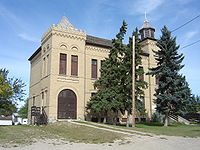 The town of Qu'Appelle was incorporated February 20, 1903 when, ironically, its halcyon days were already long behind it.
The town of Qu'Appelle was incorporated February 20, 1903 when, ironically, its halcyon days were already long behind it.
Municipal affairs are handled by the town mayor and council. The rural municipality of South Qu'appelle No. 157
office is located in Qu'Appelle and provides municipal rural affairs to the small localities of Avonhurst, Edgeley, Grassmere, Green Haven, Qu'Appelle Airport and St. Josephs Colony. South Qu'Appelle RM in 1885 was a large area comprising more than 18 townships with an area of 592 square miles (1,533.3 km²). Due its size, the council divided into 27 road districts and appointed road overseers to maintain construction and maintenance of early roads..
Qu'Appelle is in the federal electoral district of Regina—Qu'Appelle
(formerly Qu'Appelle).
Provincially, the area is within the constituency of Indian Head-Milestone
.
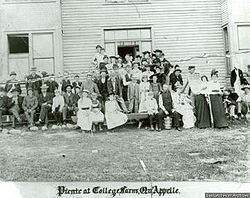 Bishop Adelbert Anson
Bishop Adelbert Anson
, the first Bishop of Qu'Appelle (1884–1892), established the St John's College Farm, a boys' school, agricultural and theological college shortly after his arrival in the diocese in 1884. When it became clear that funding from eastern Canada, the heartland of Canadian Anglicanism, would not be forthcoming, English funding for the Anglican mission on the Canadian prairies soon dried up and St. John's College dissolved shortly after Bishop Anson's departure in 1893.
December 5, 1884 saw the creation of the first two school districts in the North-West Territories
; Moose Jaw School District #1 and Qu'Appelle School District #2. The wood frame two- or three-classroom school house gave way to a 2½- storey brick school with full basement in 1906.
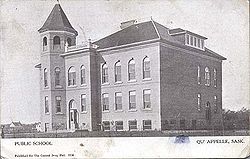 Despite the town's decline, Qu'Appelle School had a new, though temporary, lease on life in 1964 when the new consolidated school unit came in, rural schools closed and farm children began coming to school in Qu'Appelle by bus. However, education planners did not anticipate how quickly the farm hinterland would be evacuated of people as the '60s drew on: Qu'Áppelle School was closed in 1973 and demolished in 1975.
Despite the town's decline, Qu'Appelle School had a new, though temporary, lease on life in 1964 when the new consolidated school unit came in, rural schools closed and farm children began coming to school in Qu'Appelle by bus. However, education planners did not anticipate how quickly the farm hinterland would be evacuated of people as the '60s drew on: Qu'Áppelle School was closed in 1973 and demolished in 1975.
November 27, 1964 saw the opening of the nine-classroom brick James Hamblin School. Elementary school education from kindergarten to grade 9 is provided there; it is administered by the Qu'Appelle Valley School Division No. 139.
Secondary school has not been available in Qu'Appelle since 1973 when Qu'Appelle High School closed and high school students from Qu'Appelle must travel to Bert Fox Community High School in Fort Qu'Appelle, part of the Prairie Valley School Division No 208. or to Indian Head
High School. The historic Qu'Appelle High School, built in 1906 and so long a centre of town life, closed in 1973 and was demolished in 1975.
 In anticipation of its presumed eventual urban importance the Anglican
In anticipation of its presumed eventual urban importance the Anglican
ecclesiastical province of Ruperts Land designated the village of Qu'Appelle as the cathedral city of the new diocese of Qu'Appelle of the Church of England (since 1955 the Anglican Church of Canada). The diocese of Qu'Appelle still retains that name, though the historic association with the town of Qu'Appelle other than as a subsidiary congregation of the parish of Indian Head is long past. St Peter's, the pro-cathedral, was built in 1885. Its stone rectory next door is now in private hands, the church (as with the other three denominations) having long since withdrawn any full-time residential clergy from the town.
Bishop Adelbert Anson, the first Bishop of Qu'Appelle (1884), cultivated a relationship between Qu'Appelle and his home Diocese of Lichfield
in England and with wealthy friends there. They briefly took on both Diocese of Qu'Appelle as a mission field and the parish of St Peter's Pro-Cathedral as a particular focus of interest. Much of the early development of the St John's College Farm and the furnishing of St Peter's Pro-Cathedral are attributable to that early connection.
 The diocese briefly operated a training facility for Anglican clergy in the town and the St John's College Farm, a model farm immediately to the west of town. Bishop Burn, who lacked Bishop Anson's connections with patrons in the Diocese of Lichfield
The diocese briefly operated a training facility for Anglican clergy in the town and the St John's College Farm, a model farm immediately to the west of town. Bishop Burn, who lacked Bishop Anson's connections with patrons in the Diocese of Lichfield
, closed both of these facilities in 1895. The parish church of St Peter's, however, continued as the pro-cathedral
for southern Saskatchewan until 1944.
The original Bishop's Court, the official residence of the diocesan bishop, was also in Qu'Appelle. It was moved by John Burn, the second bishop of Qu'Appelle, to Indian Head
, some 8 miles (12.9 km) to the east of Qu'Appelle, in 1896 when he closed the college. It had become apparent that
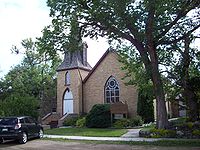 diocesan debt was becoming disproportionate to anticipated resources in the largely non-Anglican District of Assiniboia and
diocesan debt was becoming disproportionate to anticipated resources in the largely non-Anglican District of Assiniboia and
the sponsoring Diocese of Lichfield in England was unwilling to underwrite the expenses of such programs indefinitely.
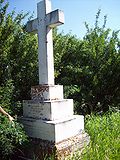 Early on, the bishop's residence was further relocated from Indian Head to the new diocesan property in Regina. Still, when Bishop Burn died he was buried in Qu'Appelle Cemetery, where his grave monument remains the largest. Ultimately, with the ecclesiastical hierarchy and the provincial metropolis long since having been removed to Regina, pro-cathedral status was removed from St Peter's, Qu'Appelle and conferred on St Paul's, Regina
Early on, the bishop's residence was further relocated from Indian Head to the new diocesan property in Regina. Still, when Bishop Burn died he was buried in Qu'Appelle Cemetery, where his grave monument remains the largest. Ultimately, with the ecclesiastical hierarchy and the provincial metropolis long since having been removed to Regina, pro-cathedral status was removed from St Peter's, Qu'Appelle and conferred on St Paul's, Regina
in 1944.
(However, even Regina's continuing status as an episcopal see city and that of St Paul's, Regina as a cathedral may now be in doubt as the further declining Anglican Church rationalises its increasingly top-heavy episcopal structure.)
(1) the Qu'Appelle Methodist Church
, which opened in 1883 as part of a circuit that included Edgeley, Saskatchewan Methodist Church. and
(2) Knox Presbyterian Church, built in 1884. The Presbyterian and Methodist congregations merged in 1925 to become a congregation of the United Church of Canada
The Presbyterian and Methodist congregations merged in 1925 to become a congregation of the United Church of Canada
. They maintained the Presbyterian church building as its facility and with the minister of Qu'Appelle Methodist Church continuing at the present day Knox United.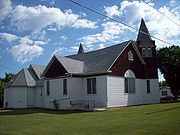 The Presbyterians of Qu'Appelle were so substantial a body that when a non-concurring minority of their congregation seceded and re-constituted themselves a separate continuing Presbyterian congregation, building a separate meeting house on Main Street for their St Andrew's Presbyterian Church, both congregations remained viable: Those who went into the union still constituted a majority of the United Church congregation and both were able to maintain a vital presence in the town for many years. From the beginning of the church union in 1925 it was clear that the continuing Presbyterians could no longer support their own local clergyman and Indian Head supplied the Qu'Appelle Presbyterians with a commuting minister who travelled to Qu'Appelle each Sunday.
The Presbyterians of Qu'Appelle were so substantial a body that when a non-concurring minority of their congregation seceded and re-constituted themselves a separate continuing Presbyterian congregation, building a separate meeting house on Main Street for their St Andrew's Presbyterian Church, both congregations remained viable: Those who went into the union still constituted a majority of the United Church congregation and both were able to maintain a vital presence in the town for many years. From the beginning of the church union in 1925 it was clear that the continuing Presbyterians could no longer support their own local clergyman and Indian Head supplied the Qu'Appelle Presbyterians with a commuting minister who travelled to Qu'Appelle each Sunday.
For a generation the church union issue raised hackles in Qu'Appelle among uniting and non-concurring Presbyterians and many firm friendships were sundered. Nowadays as elsewhere in Canada, as the matter has passed into history and matters of denominational affiliation have largely become moot in Canada's increasingly secular society, the issue is largely forgotten.
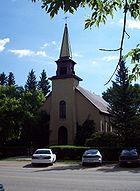 The Roman Catholics built the fine Immaculate Conception
The Roman Catholics built the fine Immaculate Conception
Church on Main Street in 1906 (consecrated in 1907). The building is in the same yellow brick as the town hall and former school, the pro-cathedral
and numerous houses and Main Street businesses, which once characterised the town's not-unimpressive yellow brick style.
Immaculate Conception parish began in 1886. Its original church building survives as a private residential dwelling. Whereas Presbyterian and Methodist, and later United, churches maintained rural congregations in which farm families locally worshipped and conducted community events, Roman Catholics as with Anglicans came to town for Sunday services and liturgical festivals and from the outset the Catholic Church in Qu'Appelle had a substantial urban presence.
The Roman Catholic constituency in Qu'Appelle was originally French, German and Métis
. As Canadian denominational affiliation has become increasingly amorphous, the Church of the Immaculate Conception's Catholicism has largely ceased to have ethnic significance.
The Parish of the Immaculate Conception has the largest church building in the town, seating up to 225. It has the most vital single surviving congregation in the town, albeit as with the Anglican, United Church and continuing Presbyterian congregations, long since without a resident clergyman.

The town's churches mounted parish, congregational, Sunday School and other events through the year which were a focus of social activity for members of the four religious denominations of the town: the Church of England
, Roman Catholics, Presbyterian
s, Methodist
s (later United Church
, containing all the Methodists and the majority of the Presbyterians) and, after the 1925 church
union, the continuing Presbyterian congregation.
There was also a cinema on Main Street which ceased to be viable with the arrival of television in the 1950s. The building had a brief reprieve in the 1960s as a general store after the closure of Hamblin's and the Red & White store; it now stands empty.
 Horse racing and harness racing were the earliest recreational activities in the area, with several avid horsemen competing in annual events. Cricket matches and hockey games were early community activities; lantern slides and movie shows were enjoyed in the late 19th century and onward when church halls and, later, when in the 1900s through the 1950s the town cinema provided movies.
Horse racing and harness racing were the earliest recreational activities in the area, with several avid horsemen competing in annual events. Cricket matches and hockey games were early community activities; lantern slides and movie shows were enjoyed in the late 19th century and onward when church halls and, later, when in the 1900s through the 1950s the town cinema provided movies.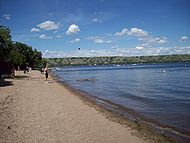 (The town cinema on Main Street remained empty for many years after the arrival of television rendered it unviable till it was briefly used in the late 1960s as a general store after the closure of the Hamblin's general store and the Red & White grocery but the business soon failed; thereafter as with most buildings on Main Street it was demolished and the site remains vacant.)
(The town cinema on Main Street remained empty for many years after the arrival of television rendered it unviable till it was briefly used in the late 1960s as a general store after the closure of the Hamblin's general store and the Red & White grocery but the business soon failed; thereafter as with most buildings on Main Street it was demolished and the site remains vacant.)
A horseshoe
pitch was set up alongside the theatre. A curling club and curling rink were established in the late 1880s.
Within the town of Qu'Appelle, the Recreation and Culture Committee oversees the activities at the skating rink, Centennial and Capital Day Parks, Community Hall, tennis court and library. The Mclean
Recreation Site 17 km (11 mi) west of Qu'Appelle to the west has a picnic area;
B-Say-Tah Point on Echo Lake, Valley Centre Recreation Site (29 km or 18 mi) also on Echo Lake at Fort Qu'Appelle, Sandy Beach and Katepwa
Point Provincial Park 27.2 kilometres (16.9 mi) on Katepwa Lake, Lebret Recreation Site 29 kilometres (18 mi) on Mission Lake and Echo Valley Provincial Park 30 kilometres (18.6 mi) on Pasqua Lake are in the Qu'Appelle Valley; Katepwa Point Provincial Park features a picnic area, beach, nine-hole golf course, miniature golf course, fishing, boating and campground. This popular beach is located on Katepwa Road
.
Mission Ridge on Mission Lake is a winter ski resort.
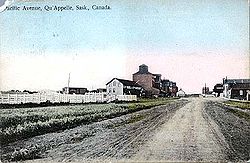 When the rail arrived in 1882, the Troy (Qu'Appelle)-Prince Albert
When the rail arrived in 1882, the Troy (Qu'Appelle)-Prince Albert
trail served freight and stagecoach transport to the north-west and onwards to Edmonton
.
The CPR formerly provided passenger service east and west from Qu'Appelle and generally throughout the province.
Early bishops of Qu'Appelle were able to travel by train from their see city of Qu'Appelle to parishes throughout southern Saskatchewan. CPR passenger services were heavily used before the arrival of widespread private motor vehicle ownership and again during the Depression; the CPR continues to run past Qu'Appelle but no longer maintains a station or passenger facilities; nor are there any longer grain elevators.
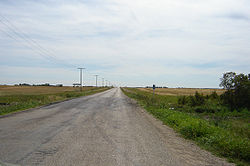 The Trans-Canada Highway was built some one kilometre to the south of the CPR tracks and the old highway, bypassing Qu'Appelle and significantly reducing traffic through the town.
The Trans-Canada Highway was built some one kilometre to the south of the CPR tracks and the old highway, bypassing Qu'Appelle and significantly reducing traffic through the town.
Highway 35
runs south to Weyburn unpaved and north to Fort Qu'Appelle; while no longer heavily trafficked since the opening of Highway 10
from Balgonie to the Valley, it is still paved on the northward sector, although with the drastically depleted population it is inevitably falling into disrepair.
The town foreman co-ordinates and manages the Public Works & Utilities Department. Qu'Appelle and the surrounding rural municipality
of South Qu'Appelle No. 157 are served by the Qu'Appelle Volunteer Fire Department, who are trained in health care and fire rescue practices. Today the Indian Head RCMP
detachment provides police protection for the community.
The Regina Qu'Appelle Regional Health Authority assesses and provides health care within the Regina-Qu'Appelle region. Regina
and Indian Head
both have hospitals and special care homes in the Regina Qu'Appelle Regional Health Authority region which are near to Qu'Appelle. Fort Qu'Appelle
is home to the Fort Qu'Appelle Community Health Services Centre, All Nations' Healing Hospital and the Echo Lodge Special Care Home.
Town
A town is a human settlement larger than a village but smaller than a city. The size a settlement must be in order to be called a "town" varies considerably in different parts of the world, so that, for example, many American "small towns" seem to British people to be no more than villages, while...
) and formerly in ecclesiastical terms a city, with considerable historic significance located on Trans-Canada Highway
Saskatchewan Highway 1
Highway 1 is the Saskatchewan section of the Trans-Canada Highway mainland route. The total distance of the Trans-Canada Highway in Saskatchewan is . The highway traverses Saskatchewan from the western border with Alberta, from Highway 1, to Manitoba where it continues as Highway 1, PTH 1. The...
and the Canadian Pacific Railway
Canadian Pacific Railway
The Canadian Pacific Railway , formerly also known as CP Rail between 1968 and 1996, is a historic Canadian Class I railway founded in 1881 and now operated by Canadian Pacific Railway Limited, which began operations as legal owner in a corporate restructuring in 2001...
(CPR) mainline, some 30 miles (48.3 km) east of the provincial capital of Regina
Regina, Saskatchewan
Regina is the capital city of the Canadian province of Saskatchewan. The city is the second-largest in the province and a cultural and commercial centre for southern Saskatchewan. It is governed by Regina City Council. Regina is the cathedral city of the Roman Catholic and Romanian Orthodox...
.
Qu'Appelle was for a time the terminus of the Canadian Pacific Railway
Canadian Pacific Railway
The Canadian Pacific Railway , formerly also known as CP Rail between 1968 and 1996, is a historic Canadian Class I railway founded in 1881 and now operated by Canadian Pacific Railway Limited, which began operations as legal owner in a corporate restructuring in 2001...
and the major distribution centre for what was then the District of Assiniboia in the North-West Territories and is now southern Saskatchewan. The town is situated in a lush rolling parkland, with intermittent coulee
Coulee
Coulee is applied rather loosely to different landforms, all of which refer to a kind of valley or drainage zone.The word coulee comes from the Canadian French coulée, from French word couler meaning "to flow"....
s containing steady-flowing creeks running into the Qu'Appelle Valley, poplar bluffs
Aspen parkland
Aspen parkland refers to a very large area of transitional biome between prairie and boreal forest in two sections; the Peace River Country of northwestern Alberta crossing the border into British Columbia, and a much larger area stretching from central Alberta, all across central Saskatchewan to...
and sloughs.
Qu'Appelle had at one stage been credibly anticipated to be the major metropole
Metropole
The metropole, from the Greek Metropolis 'mother city' was the name given to the British metropolitan centre of the British Empire, i.e. the United Kingdom itself...
of the North-West Territories by both the federal government
Government of Canada
The Government of Canada, formally Her Majesty's Government, is the system whereby the federation of Canada is administered by a common authority; in Canadian English, the term can mean either the collective set of institutions or specifically the Queen-in-Council...
and the Church of England (now the Anglican Church of Canada
Anglican Church of Canada
The Anglican Church of Canada is the Province of the Anglican Communion in Canada. The official French name is l'Église Anglicane du Canada. The ACC is the third largest church in Canada after the Roman Catholic Church and the United Church of Canada, consisting of 800,000 registered members...
). It was under serious consideration by the federal government as district headquarters of the District of Assiniboia and territorial headquarters of the North-West Territories
Territorial evolution of Canada
The federation of Canada was created in 1867 when three colonies of British North America were united. One of these colonies split into two new provinces, three other colonies joined later...
. The Church of England had in anticipation of Qu'Appelle's future urban importance designated it the cathedral city for the Diocese of Qu'Appelle, which geographically corresponded precisely to the District of Assiniboia in the North-West Territories.
Political events, however, passed Qu'Appelle entirely by when Lieutenant-Governor
Lieutenant governor
A lieutenant governor or lieutenant-governor is a high officer of state, whose precise role and rank vary by jurisdiction, but is often the deputy or lieutenant to or ranking under a governor — a "second-in-command"...
Edgar Dewdney
Edgar Dewdney
Edgar Dewdney, PC was a Canadian politician born in Devonshire, England. He served as Lieutenant Governor of the North-West Territories and the fifth Lieutenant Governor of British Columbia.-Early life and career:...
selected the locale of his own landholdings at Pile-O-Bones
Regina, Saskatchewan
Regina is the capital city of the Canadian province of Saskatchewan. The city is the second-largest in the province and a cultural and commercial centre for southern Saskatchewan. It is governed by Regina City Council. Regina is the cathedral city of the Roman Catholic and Romanian Orthodox...
(then re-named "Regina") as his Territorial capital: Qu'Appelle's significance other than in historical terms then largely lapsed.
Name

Canadian Pacific Railway
The Canadian Pacific Railway , formerly also known as CP Rail between 1968 and 1996, is a historic Canadian Class I railway founded in 1881 and now operated by Canadian Pacific Railway Limited, which began operations as legal owner in a corporate restructuring in 2001...
arrived in 1882-83, and the post office was founded at what was originally called Troy on August 1, 1882. For a time Qu'Appelle appeared likely to be the administrative headquarters for the District of Assiniboia, which corresponded to the southern portion of the present day province of Saskatchewan.
Two versions of the origin of the name "Troy" are proposed: That
(1) it was named after Troy, Ontario by Wellington Mulholland, a land surveyor and land agent and
(2) the name was chosen by the brothers Stephen and James Caswell who were merchants in the area and managed the post office.
Original settlers hung onto the old name of "Troy" well into the 20th century.

Canadian Pacific Railway
The Canadian Pacific Railway , formerly also known as CP Rail between 1968 and 1996, is a historic Canadian Class I railway founded in 1881 and now operated by Canadian Pacific Railway Limited, which began operations as legal owner in a corporate restructuring in 2001...
arrived in 1884 the new town was renamed Qu'Appelle Station in reference to the nearby Qu'Appelle Valley, which was the location of a long-established Hudson's Bay Company
Hudson's Bay Company
The Hudson's Bay Company , abbreviated HBC, or "The Bay" is the oldest commercial corporation in North America and one of the oldest in the world. A fur trading business for much of its existence, today Hudson's Bay Company owns and operates retail stores throughout Canada...
factory. The name "Qu'Appelle," a corruption of qui appelle, French for "Who calls?" refers to the once-popular legend of the Qu'Appelle Valley popularly versified by E. Pauline Johnson.
In 1902 the name was changed to South Qu'Appelle and in 1911 the longstanding confusion as to the name "Qu'Appelle," which also referred to the former Hudson's Bay Company
Hudson's Bay Company
The Hudson's Bay Company , abbreviated HBC, or "The Bay" is the oldest commercial corporation in North America and one of the oldest in the world. A fur trading business for much of its existence, today Hudson's Bay Company owns and operates retail stores throughout Canada...
fort town in the Qu'Appelle Valley, to the northeast of Qu'Appelle, was resolved when the two communities agreed to deem the then-CPR
Canadian Pacific Railway
The Canadian Pacific Railway , formerly also known as CP Rail between 1968 and 1996, is a historic Canadian Class I railway founded in 1881 and now operated by Canadian Pacific Railway Limited, which began operations as legal owner in a corporate restructuring in 2001...
station site as Qu'Appelle and the town in the valley as Fort Qu'Appelle.
Establishment

Hudson's Bay Company
The Hudson's Bay Company , abbreviated HBC, or "The Bay" is the oldest commercial corporation in North America and one of the oldest in the world. A fur trading business for much of its existence, today Hudson's Bay Company owns and operates retail stores throughout Canada...
trading temporarily stood southwest of the future site of the town from 1854 through 1864 when it was re-located back to its previous site, the modern Fort Qu'Appelle
Fort Qu'Appelle, Saskatchewan
These figures do not include the substantial population living along the shores of the Fishing Lakes.-Origins:The current site is the third Fort Qu'Appelle. The first was a North West Company trading post , also in the valley but near what is now the Saskatchewan-Manitoba border...
in the Qu'Appelle Valley.
Qu'Appelle was at one point among the likely choices as capital of the North-West Territories, as indicated by its original status as the historical see city of the Anglican Diocese of Qu'Appelle. The choice of Pile-of-Bones, as Regina was originally called, as the Territorial headquarters was a national scandal in the 1880s: there was an "obvious conflict of interest" in Lieutenant-Governor Edgar Dewdney
Edgar Dewdney
Edgar Dewdney, PC was a Canadian politician born in Devonshire, England. He served as Lieutenant Governor of the North-West Territories and the fifth Lieutenant Governor of British Columbia.-Early life and career:...
's promoting of Pile-of-Bones as the territorial headquarters. A 1980 local town history reports that
In his January 5, 1892 edition of the Regina Leader, Nicholas Flood DavinNicholas Flood DavinNicholas Flood Davin Nicholas Flood Davin was a lawyer, journalist and politician, born at Kilfinane, Ireland. The first MP for Assiniboia West , Davin was known as the voice of the North-West....
explained what in his mind, and in the minds of most of the people in this area, was the real reason Qu'Appelle was not chosen, or rather why Pile of Bones was Dewdney's choice. According to Mr. Davin, Lieutenant-Governor Dewdney and fourteen other men formed a syndicate and bought Hudson Bay section along the C.P.R. Mainline....He chose the town site of Regina...about a mile (1.6 km) west of the present station—that is, on their own section '26'."
Until 1897, however, when responsible government
Responsible government
Responsible government is a conception of a system of government that embodies the principle of parliamentary accountability which is the foundation of the Westminster system of parliamentary democracy...
was accomplished in the Territories, the lieutenant-governor and council governed by fiat and there was little legitimate means of challenging such decisions outside the federal capital of Ottawa
Ottawa
Ottawa is the capital of Canada, the second largest city in the Province of Ontario, and the fourth largest city in the country. The city is located on the south bank of the Ottawa River in the eastern portion of Southern Ontario...
, where the Territories were remote and of little concern.
North-West Rebellion

North-West Rebellion
The North-West Rebellion of 1885 was a brief and unsuccessful uprising by the Métis people of the District of Saskatchewan under Louis Riel against the Dominion of Canada...
. Until the construction of the Qu’Appelle, Long Lake, and Saskatchewan Railway in 1890 linked the newly-established Regina with Saskatoon and Prince Albert, Qu'Appelle was the major debarkation and distribution centre for the North-West Territories.

Frederick Dobson Middleton
General Sir Frederick Dobson Middleton KCMG, CB was a British general noted for his service throughout the Empire and particularly in the North-West Rebellion.-Military career:...
, who billeted in Qu'Appelle's Queen's Hotel (which survived into the 21st century), made Qu'Appelle the marshalling point to the locus of the North-West Rebellion
North-West Rebellion
The North-West Rebellion of 1885 was a brief and unsuccessful uprising by the Métis people of the District of Saskatchewan under Louis Riel against the Dominion of Canada...
(the Saskatchewan or Second Riel Rebellion) in the north-west for troops arriving by train from eastern Canada. For some years Qu'Appelle was the centre of national attention as journalists based there reported back home to eastern Canada on developments in the Saskatchewan Rebellion.
The resolution of the Saskatchewan Rebellion perhaps needless to say did not comprehensively resolve conflicts among settlers and aboriginal people. Many Qu'Appelle children of the late 19th and early 20th centuries recounted frightening encounters with angry Cree and Métis, who not unreasonably bore a considerable grudge against white settlers in the Qu'Appelle region..
Early town life and economy
From 1882, early residents of Qu'Appelle included numerous English remittance men whose cultured backgrounds contributed significantly to the life of the town. Amateur theatricals and musical evenings were a regular feature of winter social life and it was important to early Qu'Appelle residents that there be an "opera house": an auditorium in the town hall.As in Fort Qu'Appelle
Fort Qu'Appelle, Saskatchewan
These figures do not include the substantial population living along the shores of the Fishing Lakes.-Origins:The current site is the third Fort Qu'Appelle. The first was a North West Company trading post , also in the valley but near what is now the Saskatchewan-Manitoba border...
, town life in many ways resembled that of an Indian hill station during the British Raj. Perhaps improbably in so small a community but indicative of the not always tolerant and inclusive social mores of early settlement in the Canadian west, discrete neighbourhoods of Qu'Appelle were called "Germantown" and "Breedville," the latter in racist early reference to the prairie Anglo-Métis
Anglo-Métis
A 19th-century community of the Métis people of Canada, the Anglo-Métis, more commonly known as Countryborn, were children of fur traders; they typically had Orcadian, Scottish, or English fathers and Aboriginal mothers. Their first languages were generally those of their mothers: Cree, Saulteaux,...
, whom white settlers at the time called "half-breeds," a term now considered disparaging, and generally avoided.

The fine yellow brick town hall and "opera house" remains marginally in use, though its auditorium has long since been closed to public use because it falls short of modern standards of safety and the town cannot bring it up. Its companion building, Qu'Appelle High School, built in similar style in identical yellow brick, closed in 1973 and was demolished in 1975. The Queen's Hotel, built in 1884, survived, latterly largely as a town pub, until its destruction by fire in 2003.

Canadian Pacific Railway
The Canadian Pacific Railway , formerly also known as CP Rail between 1968 and 1996, is a historic Canadian Class I railway founded in 1881 and now operated by Canadian Pacific Railway Limited, which began operations as legal owner in a corporate restructuring in 2001...
until 1907, when the observatory was supplemented with anemometer and weather recording devices.. observatory The Qu'Appelle Felt and Boot factory opened at the end of 1897 but liquidated in 1900.. A fire in 1883 destroyed much of the new business district but soon there were six stores, three hotels, five implement agencies, two butcher shops, a flour and feed store and a bakery.

Thomas Walter Scott
Thomas Walter Scott – known less formally as Walter Scott – was the first Premier of the province of Saskatchewan in Canada .-Background:...
's prohibition and temperance legislation), barber shop, firehall, law office, numerous service stations, several cafés, cinema (later converted to a grocery store, also now closed) and a covered rink. In the 1890s, there was "a flour mill, a creamery [and] a felt and boot factory."
The Qu'Appelle Anglican Diocese maintained the St John's College Farm immediately to the west of town. By 1910 the town's population had risen to nearly 1,000. Qu'Appelle was an important local business, shopping and distribution centre which, staged an annual summer fair.

Wilfrid Laurier
Sir Wilfrid Laurier, GCMG, PC, KC, baptized Henri-Charles-Wilfrid Laurier was the seventh Prime Minister of Canada from 11 July 1896 to 6 October 1911....
-Sifton
Clifford Sifton
Sir Clifford Sifton, PC, KCMG was a Canadian politician best known for being Minister of the Interior under Sir Wilfrid Laurier...
migration of the last decade of the nineteenth century and first decade of the twentieth, much of the settlement in the Qu'Appelle District was by well-capitalised eastern Canadians and Britons. Rather than the small sod and plain lumber houses and outbuildings of later homesteaders, farm as well as town residential and outbuilding construction here was frequently large, ostentatious and built of brick or stone, often with large formal gardens, indicating not only the large families of the time but the anticipation of considerable prosperity and the ability to employ domestic help.
Town amenities of the early decades of settlement were contingent on the farming hinterland being far more densely populated than today; travel to Regina was accomplished via a train journey and domestic transport mostly by horse drawn conveyances. With the vastly depleted rural population and improved transport these amenities have almost wholly lapsed. The rationalisation by the grain companies of their depots for buying grain from farmers and the resulting disappearance of Qu'Appelle's grain elevators hastened the process of decline as even the regular visits by farmers to town to deliver grain ceased.
Settlement colonies
As with the nearby large farming projects Bell Farm and Cannington ManorCannington Manor Provincial Park
Cannington Manor Provincial Park is a historic park which was established in 1882 by Captain Edward Michell Pierce as an aristocratic English colony...
, there were also large farming ventures near Qu'Appelle. W. Thistle and Thomas Wright started the Wright farm in 1882 on four sections
Dominion Land Survey
The Dominion Land Survey is the method used to divide most of Western Canada into one-square-mile sections for agricultural and other purposes. It is based on the layout of the Public Land Survey System used in the United States, but has several differences...
of land (one section having been one square mile, 640 acres or 2.6 km²). By 1884, there were 770 acres (3.1 km²) in crops and 1050 acres (4.2 km²) tilled and ready for seed.
. W.R. Sykes laid down $In 1884, the Wrights...owned a steam threshing machine four binders, twelve teams of horses, four yokes of oxen, forty-five head of cattle six sulky plow six common plows, four seeders and a number of mowers and harrows. They also had three frame granaries with a capacity of 2500 bushels.
.
Canadian dollar
The Canadian dollar is the currency of Canada. As of 2007, the Canadian dollar is the 7th most traded currency in the world. It is abbreviated with the dollar sign $, or C$ to distinguish it from other dollar-denominated currencies...
32,000 for farm equipment to establish the W.R. Sykes English Company farm. ($32,000 is equivalent to $ in present day terms.) W.R. Sykes purchased eighteen sections of land north of Qu'Appelle and brought in the first first steam plows to Western Canada. An advertisement featuring the Lord Brassey farm and estate was run in England and attracted farmers to the Church Colonisation Society venture called the Christ Church Settlement. In the 4¾ sections bought by the Church Colonisation Society 40 acres (16.2 ha) were set aside for each family. Amongst initial setbacks, the major blow came when the Dominion Land Survey
Dominion Land Survey
The Dominion Land Survey is the method used to divide most of Western Canada into one-square-mile sections for agricultural and other purposes. It is based on the layout of the Public Land Survey System used in the United States, but has several differences...
offered 160 acres (64.7 ha) to settlers, making the 40 acres (161,874.4 m²) a mere pittance in comparison.. In 1885 #1 hard wheat was selling for $0.62 a bushel.. As a comparison to these large farms, the average homesteader on his single quarter section of land could barely afford a team of oxen which in 1882 cost around $250. At the time a good team of horses would run about $600.. ($250 is equivalent to $ in present day terms and $600 is equivalent to $ )
Decline

Nomination of Regina as territorial capital
The catastrophe of Lieutenant-Governor Edgar Dewdney nominating Pile-of-BonesRegina, Saskatchewan
Regina is the capital city of the Canadian province of Saskatchewan. The city is the second-largest in the province and a cultural and commercial centre for southern Saskatchewan. It is governed by Regina City Council. Regina is the cathedral city of the Roman Catholic and Romanian Orthodox...
, later Regina, as his Territorial Capital was only the first of the disasters to befall Qu'Appelle. The opening of the Qu'Appelle, Long Lake and Saskatchewan Railway in 1890, which linked linked Regina, Saskatoon and Prince Albert, ended Qu'Appelle's important role as a distribution centre. Bishop Burn's closing of the Qu'Appelle Model Farm and transfer of Bishop's Court (the bishop's "palace") from Qu'Appelle to Indian Head
Indian Head, Saskatchewan
Indian Head is a town in southeast Saskatchewan, Canada, east of Regina. The town is directly north of the Trans-Canada Highway. The town is known for its federally-operated Prairie Farm Rehabilitation Administration experimental farm and tree nursery that produces seedlings for shelter...
in 1895 accelerated the decline. Thereafter Qu'Appelle's pretensions as the would-be metropole for the District of Assiniboia were comprehensively dispelled.
Alienation of Anglican see status
The Anglican metropole was first unofficially transferred from Qu'Appelle to Indian Head, when Bishop Burn moved Bishop's Court; it was subsequently further transferred to Regina. The process was completed in 1944 when St Peter's lost pro-cathedralPro-cathedral
A pro-cathedral is a parish church that is temporarily serving as the cathedral or co-cathedral of a diocese.-Usage:In Ireland, the term is used to specifically refer to St Mary's Pro-Cathedral in Dublin, the seat of the Roman Catholic Archbishop of Dublin since the Reformation, when Christ Church...
status, which was then conferred on St Paul's Regina
St. Paul's Cathedral (Regina)
St Paul's Anglican Cathedral is an historic church building located on the outskirts of Regina's central business district. Built as a parish church in 1894-1895, it became the pro-cathedral of the Anglican Diocese of Qu'Appelle, in southern Saskatchewan, Canada in 1944 when pro-cathedral status...
.
Depletion of hinterland and erosion of commercial viablity

Esso
Esso is an international trade name for ExxonMobil and its related companies. Pronounced , it is derived from the initials of the pre-1911 Standard Oil, and as such became the focus of much litigation and regulatory restriction in the United States. In 1972, it was largely replaced in the U.S. by...
and Royalite
Gulf Oil
Gulf Oil was a major global oil company from the 1900s to the 1980s. The eighth-largest American manufacturing company in 1941 and the ninth-largest in 1979, Gulf Oil was one of the so-called Seven Sisters oil companies...
stations on the now-relocated trans-Canada highway to the south of the town). These were not to last beyond 1970.
The upgrading of the trans-Canada highway
Trans-Canada Highway
The Trans-Canada Highway is a federal-provincial highway system that joins the ten provinces of Canada. It is, along with the Trans-Siberian Highway and Australia's Highway 1, one of the world's longest national highways, with the main route spanning 8,030 km...
in the immediate post-World War II years with the highway being re-routed to the south took east-west traffic outside the town; the CPR continued to provide passenger and freight services only briefly after the War as private auto ownership became normative, and freight transport increasingly was delegated from the railways to highway trucking, and Qu'Appelle CPR station eventually closed and was demolished.
The long-disused movie theatre building on Main Street across the street from the Kraus BA
Gulf Oil
Gulf Oil was a major global oil company from the 1900s to the 1980s. The eighth-largest American manufacturing company in 1941 and the ninth-largest in 1979, Gulf Oil was one of the so-called Seven Sisters oil companies...
garage briefly was turned into a general store in the 1960s when Hamblin's General Store and the Red & White Store closed but this soon ended. The bypassing of Qu'Appelle by Highway 10
Saskatchewan Highway 10
Highway 10 is a provincial paved undivided highway in the Canadian province of Saskatchewan. It runs from Highway 1 near Balgonie until it transitions into PTH 5 at the Manitoba border. Highway 10 is about 228 km long....
to the Qu'Appelle Valley, the closing of the grain elevators and the gas stations, the high school and all the remaining grocery stores determinatively spelled the end of Qu'Appelle as a viable commercial centre.
Contemporary issues

Saskatchewan Highway 10
Highway 10 is a provincial paved undivided highway in the Canadian province of Saskatchewan. It runs from Highway 1 near Balgonie until it transitions into PTH 5 at the Manitoba border. Highway 10 is about 228 km long....
cut across directly from Balgonie
Balgonie, Saskatchewan
-Sports:Home of Team Selzer, World Women's Curling Silver Medalists, and consistently competitive high school volleyball and soccer programs.-References:...
to the Valley. In recent years Qu'Appelle has enjoyed a mild resurgence as a result of commuters from Regina discovering it as a bedroom community, but local commerce has never recovered and there are no longer any retail outlets, service stations, banks, barbers or beauty parlours or a post office in the town.
To encourage population growth, the town council for a time advertised lots for sale at one dollar as a means of attracting new residents, and several mobile homes in town are the result. According to the Encyclopedia of Saskatchewan "about 80% to 90% of the town’s workforce drives to and from the city each day" With the resulting dearth of local commerce the once solidly built up main street is now almost entirely lined with vacant lots and abandoned buildings. A succession of fires from the 1950s through the 2000s comprehensively removed wooden historic commercial buildings from Main Street.

History of the petroleum industry in Canada
The Canadian petroleum industry arose in parallel with that of the United States. Because of Canada's unique geography, geology, resources and patterns of settlement, however, it developed in different ways...
and BA
Gulf Oil
Gulf Oil was a major global oil company from the 1900s to the 1980s. The eighth-largest American manufacturing company in 1941 and the ninth-largest in 1979, Gulf Oil was one of the so-called Seven Sisters oil companies...
stations on the trans-Canada highway
Saskatchewan Highway 1
Highway 1 is the Saskatchewan section of the Trans-Canada Highway mainland route. The total distance of the Trans-Canada Highway in Saskatchewan is . The highway traverses Saskatchewan from the western border with Alberta, from Highway 1, to Manitoba where it continues as Highway 1, PTH 1. The...
and two garages in town operated by the Kuntz and Kraus families. The historic Queen's Hotel, built in 1884 and perhaps the last of the major commercial structures of Main Street, burned to the ground in 2003.
James Hamblin School, the town primary school built in the 1960s and named for the proprietor of the long-operating (but now long-defunct) Main Street general store, remains in operation with nine staff and an enrolment of 156 in 2007. The Saskatchewan library association maintains a travelling library in the Town Hall with internet access to the province-wide collection and provides facilities for ordering books from such collection. This is in contrast with the otherwise sadly depleted resources of today's Qu'Appelle by comparison with the burgeoning community of the past.

Great Depression
The Great Depression was a severe worldwide economic depression in the decade preceding World War II. The timing of the Great Depression varied across nations, but in most countries it started in about 1929 and lasted until the late 1930s or early 1940s...
Susan Buchan (Lady Tweedsmuir), Vicereine of Canada and wife of John Buchan (Lord Tweedsmuir)
Baron Tweedsmuir
Baron Tweedsmuir, of Elsfield in the County of Oxford, is a title in the Peerage of the United Kingdom. It was created in 1935 for the author and Conservative politician John Buchan. He served as Governor-General of Canada from 1935 to his death in 1940. His eldest son, the second Baron, was the...
, the then-eminent novelist who was Governor General of Canada, established a library project by which used books were collected in Eastern Canada and distributed by the train carload throughout western Canada free of charge so long as local persons would pick up the freight charge.
Assorted Qu'Appelle persons were able to do so. Qu'Appelle library in the Town Hall and the rural schools of the Qu'Appelle District accumulated libraries through Lady Tweedsmuir's project when local patrons were able to pay the freight; the 1940s, 50s and 60s rural schools and indeed farm houses still had libraries remaining from her project.

Esso
Esso is an international trade name for ExxonMobil and its related companies. Pronounced , it is derived from the initials of the pre-1911 Standard Oil, and as such became the focus of much litigation and regulatory restriction in the United States. In 1972, it was largely replaced in the U.S. by...
service station briefly enjoyed a second life as a general store during the 1960s when James Hamblin's general store closed on his death but it lasted only for a decade.
The Qu'Appelle Royal Bank of Canada
Royal Bank of Canada
The Royal Bank of Canada or RBC Financial Group is the largest financial institution in Canada, as measured by deposits, revenues, and market capitalization. The bank serves seventeen million clients and has 80,100 employees worldwide. The company corporate headquarters are located in Toronto,...
branch, built in 1906 by the Northern Bank and taken over by the Royal Bank of Canada in 1925, is located on the east side of Main Street. The branch continued to operate until the 1960s when reduced commercial activity in Qu'Appelle and declining population in the hinterland made it no longer viable. The building is now in use as a commercial laboratory.
At present there remains a small business core, gas station, grocery store, butcher shop, insurance agency, post office, two restaurants, bar, greenhouses, transport grain storage, hair dresser, a print shop, tattoo parlour and analytical laboratory. The Odd Fellows, a local service club, is long dissolved. There still remains a Masons lodge, a Lions Club, the Community Players and a Historical Society. Skating rink, baseball diamonds, with a nearby indoor horseback riding arenas, elementary school and RM office.

By the 1960s many farmers were working in winter in "town" — not Qu'Appelle, whose commercial vitality had by now entirely lapsed, but certainly Fort Qu'Appelle and indeed Regina — and winter social activities in the former rural communities had entirely lapsed. Farming had become a part-time summer job for farmers, who previously would have regarded farming as their principal occupation and wintertime jobs as a distraction.
The availability of unlimited water on farmsteads became an issue when the Government of Saskatchewan at length permitted the subdivision of farmsteads: when this became viable, numerous luxurious farmsteads became attractive venues for townspeople to set up summer homes on former Qu'Appelle district farmsteads with the former farms consolidated as large-scale commercial operations having no relationship whatever with their former farmsteads.

Ontario
Ontario is a province of Canada, located in east-central Canada. It is Canada's most populous province and second largest in total area. It is home to the nation's most populous city, Toronto, and the nation's capital, Ottawa....
, it was not nearly enough in the dryland farming conditions of the prairies, and farmers steadily sold up or bought up, farm sizes increased and the hinterland population waned.
Rural churches
United Church of Canada
The United Church of Canada is a Protestant Christian denomination in Canada. It is the largest Protestant church and, after the Roman Catholic Church, the second-largest Christian church in Canada...
, largely Presbyterian and then as of 1925 United Church, served by ministers based in Qu'Appelle, Indian Head and Fort Qu'Appelle, and rural one-room schools
Education in Saskatchewan
Education in Saskatchewan, Canada teaches a curriculum of learning set out by the Government of Saskatchewan through the Ministry of Education. The curriculum sets out to develop skills, knowledge, understanding to improve the quality of life. June 22, 1915, Hon...
closed by the late 1950s and early 1960s respectively: all rural churches were gone by 1960 and the remaining rural schools were closed in June, 1963; farm children were thereafter bused to town school. Little trace of either now remains as rural schools' and churches' property was resumed by local farmers.
Geography

Above mean sea level
The term above mean sea level refers to the elevation or altitude of any object, relative to the average sea level datum. AMSL is used extensively in radio by engineers to determine the coverage area a station will be able to reach...
. The area is characterised by lush rolling grasslands, interspersed with poplar
Aspen
Populus section Populus, of the Populus genus, includes the aspen trees and the white poplar Populus alba. The five typical aspens are all native to cold regions with cool summers, in the north of the Northern Hemisphere, extending south at high altitudes in the mountains. The White Poplar, by...
bluffs (in prairie Canadian terminology poplar groves surrounding sloughs) and open sloughs. Qu'Appelle is located in the transition zone between the Qu'Appelle River and the corresponding Qu'Appelle Valley and the Canadian Prairies
Canadian Prairies
The Canadian Prairies is a region of Canada, specifically in western Canada, which may correspond to several different definitions, natural or political. Notably, the Prairie provinces or simply the Prairies comprise the provinces of Alberta, Saskatchewan, and Manitoba, as they are largely covered...
.

Natural features of Egg Lake (20.6 km (13 mi)); Echo Creek (14.8 km (9 mi)); the Fishing Lakes
Fishing Lakes
The Fishing Lakes are a chain of four lakes in the Qu'Appelle Valley cottage country some 40 miles to the northeast of Regina, Saskatchewan....
(25.1 km (16 mi)) and Strawberry Lakes (27.7 km (17 mi)) are near Qu'Appelle. The Fishing Lakes—Katepwa, Mission, Echo and Pasqua Lakes—immediately to the north of the Qu'Appelle in the Qu'Appelle Valley, are all fed by the Qu'Appelle River.
The Indian Head Bird Sanctuary, maintained by the Canada Agriculture Experimental Farm Tree Nursery is located 14 km (9 mi) east of Qu'Appelle. The sanctuary is a mixed-grass prairie eco-region and wetlands created by the damming of the Indian Head Creek.
Climate

Semi-arid
A semi-arid climate or steppe climate describes climatic regions that receive precipitation below potential evapotranspiration, but not extremely...
, highland continental climate
Continental climate
Continental climate is a climate characterized by important annual variation in temperature due to the lack of significant bodies of water nearby...
with dry winters and cool summers (Koppen climate classification
Köppen climate classification
The Köppen climate classification is one of the most widely used climate classification systems. It was first published by Crimea German climatologist Wladimir Köppen in 1884, with several later modifications by Köppen himself, notably in 1918 and 1936...
BSk, Qu'Appelle's winters can be uncomfortably cold; but warm, dry Chinook wind
Chinook wind
Chinook winds , often called chinooks, commonly refers to foehn winds in the interior West of North America, where the Canadian Prairies and Great Plains meet various mountain ranges, although the original usage is in reference to wet, warm coastal winds in the Pacific Northwest.Chinook is claimed...
s routinely blow into the city from the Pacific Ocean
Pacific Ocean
The Pacific Ocean is the largest of the Earth's oceanic divisions. It extends from the Arctic in the north to the Southern Ocean in the south, bounded by Asia and Australia in the west, and the Americas in the east.At 165.2 million square kilometres in area, this largest division of the World...
during the winter months, providing the occasional break from the cold especially during the times of El Niño-Southern Oscillation
El Niño-Southern Oscillation
El Niño/La Niña-Southern Oscillation, or ENSO, is a quasiperiodic climate pattern that occurs across the tropical Pacific Ocean roughly every five years...
. These winds have been known to raise the winter temperature by up to 15 C-change in just a few hours.
Qu'Appelle is a town of extremes, and temperatures have ranged anywhere from a record low of -42 C in 1983 to a record high of 38.5 °C (101.3 °F) in 1988. According to Environment Canada
Environment Canada
Environment Canada , legally incorporated as the Department of the Environment under the Department of the Environment Act Environment Canada (EC) (French: Environnement Canada), legally incorporated as the Department of the Environment under the Department of the Environment Act Environment...
, the average temperature in Qu'Appelle ranges from a January daily average of -15.5 C to a July daily average of 18.3 °C (64.9 °F).
As a consequence of Qu'Appelle's relative dryness, summer evenings can be very cool, the average summer minimum temperature drops to 10.6 °C (51.1 °F). Qu'Appelle has a semi-arid
Semi-arid
A semi-arid climate or steppe climate describes climatic regions that receive precipitation below potential evapotranspiration, but not extremely...
climate typical of other cities in the Western Great Plains
Great Plains
The Great Plains are a broad expanse of flat land, much of it covered in prairie, steppe and grassland, which lies west of the Mississippi River and east of the Rocky Mountains in the United States and Canada. This area covers parts of the U.S...
and Canadian Prairies.
Qu'Appelle receives an average of 452.5 mm (17.81 in) of precipitation annually, with 340.6 mm (13.41 in) of that occurring in the form of rain, and the remaining 111.9 mm of precipitation as 111.9 cm (44.1 in) of snow. Most of the precipitation occurs from May to August, with June and July averaging the most monthly rainfall. On 13 July 1981, Qu'Appelle received 113.1 mm (4.45 in) of precipitation, making it the wettest day in the town's recorded history
Recorded history
Recorded history is the period in history of the world after prehistory. It has been written down using language, or recorded using other means of communication. It starts around the 4th millennium BC, with the invention of writing.-Historical accounts:...
. On 12 May 1983, Qu'Appelle received 45 cm (18 in) of snowfall, providing the snowiest day in the town's recorded history
Recorded history
Recorded history is the period in history of the world after prehistory. It has been written down using language, or recorded using other means of communication. It starts around the 4th millennium BC, with the invention of writing.-Historical accounts:...
. Droughts are not uncommon and may occur at any time of the year, lasting sometimes for months or even several years.
Demographics
The 2006 Statistics CanadaStatistics Canada
Statistics Canada is the Canadian federal government agency commissioned with producing statistics to help better understand Canada, its population, resources, economy, society, and culture. Its headquarters is in Ottawa....
data estimates the town's population at 624 residents, continuing a trend of population decline in the town since the 2001 Census
Canada 2001 Census
The Canada 2001 Census was a detailed enumeration of the Canadian population. Census day was May 15, 2001. On that day, Statistics Canada attempted to count every person in Canada. The total population count of Canada was 30,007,094. This was a 4% increase over 1996 Census of 28,846,761. In...
. Of this population, 48.8 per cent were male and 51.2 per cent were female. Children under five accounted for approximately 4.8 per cent of the resident population of Qu'Appelle.
Between 2001 and 2006, Qu'Appelle's population decreased by 3.7 percent. During the same time period, the population of Saskatchewan
Saskatchewan
Saskatchewan is a prairie province in Canada, which has an area of . Saskatchewan is bordered on the west by Alberta, on the north by the Northwest Territories, on the east by Manitoba, and on the south by the U.S. states of Montana and North Dakota....
decreased by 1.1 percent, while that of Canada grew by 5.4 percent. The population density of Qu'Appelle averaged 147.7 PD/km2, compared with an average of 1.6 /km2 for the province. According to data from 2001 (although with so small a population percentages are not especially informative) more than 36.9% of the town's residents identify themselves as Roman Catholic; 38.46% of residents are Protestant, 2.3% are undifferentiated Christian, 5.38% are Buddhist, and 16.9% of residents do not practise a religion.
Qu'Appelle is a part of Census Division No. 6
Division No. 6, Saskatchewan
Division No. 6, Saskatchewan, Canada, is one of the eighteen census divisions within the province, as defined by Statistics Canada. It is located in the south-central part of the province. The most populous community in this division is Regina, the provincial capital.According to the 2006 census,...
. Qu'Appelle and area do not belong to a Saskatchewan Regional Economic Development Authority, REDA.
According to the Canada 2001 Census
Canada 2001 Census
The Canada 2001 Census was a detailed enumeration of the Canadian population. Census day was May 15, 2001. On that day, Statistics Canada attempted to count every person in Canada. The total population count of Canada was 30,007,094. This was a 4% increase over 1996 Census of 28,846,761. In...
the community profile was as follows:
- Population in 1996 — 632
-
-
- N/A = Data Not Available
-
Media

Latterly it devolved to a local community paper, largely subsisting on reports from farm wives as to the waning hinterland rural communities. Community reporters phoned in accounts of events in such now historic rural communities as Inglewood, Strathcarroll and Springbrook.
Rural community life increasingly lapsed through the 1960s and reports from farm wives to the Qu'Appelle Progress of community events became redundant as such rural communities waned, lost cohesion and ultimately vanished.
By that time such rural communities had passed into their brief, three-generation history, Heber Ellis, the editor and publisher of The Progress had reached the end of his life and The Progress died soon after him.
Nowadays the Qu'Appelle Spirit Monthly newsletter provides local reporting from volunteers.
Governance

Municipal affairs are handled by the town mayor and council. The rural municipality of South Qu'appelle No. 157
South Qu'appelle No. 157, Saskatchewan
This article is about the rural municipality in Canada. For other places with the same name, see Qu'appelleSouth Qu'appelle No. 157, Saskatchewan is a rural municipality of 1,066 rural residents in the southeastern part of Saskatchewan, Canada. The RM was incorporated August 6, 1884...
office is located in Qu'Appelle and provides municipal rural affairs to the small localities of Avonhurst, Edgeley, Grassmere, Green Haven, Qu'Appelle Airport and St. Josephs Colony. South Qu'Appelle RM in 1885 was a large area comprising more than 18 townships with an area of 592 square miles (1,533.3 km²). Due its size, the council divided into 27 road districts and appointed road overseers to maintain construction and maintenance of early roads..
Qu'Appelle is in the federal electoral district of Regina—Qu'Appelle
Regina—Qu'Appelle
Regina—Qu'Appelle is a federal electoral district in Saskatchewan, Canada, that has been represented in the Canadian House of Commons from 1904 to 1968 and since 1988.-Geography:...
(formerly Qu'Appelle).
Provincially, the area is within the constituency of Indian Head-Milestone
Indian Head-Milestone
Indian Head-Milestone is a provincial electoral district for the Legislative Assembly of Saskatchewan, Canada. Located in southern Saskatchewan, this constituency was created through the Representation Act, 1994 by combining the district of Indian Head-Wolseley with part of the constituency of...
.
Education

Adelbert John Robert Anson
The Rt Rev Adelbert John Robert Anson, DD, MA was an Anglican Bishop in late 19th century western Canada..A controversial figure in his diocese, at least among native Canadian farmers and townspeople, he encouraged the small English community to stand fast and remain aloof against the surrounding...
, the first Bishop of Qu'Appelle (1884–1892), established the St John's College Farm, a boys' school, agricultural and theological college shortly after his arrival in the diocese in 1884. When it became clear that funding from eastern Canada, the heartland of Canadian Anglicanism, would not be forthcoming, English funding for the Anglican mission on the Canadian prairies soon dried up and St. John's College dissolved shortly after Bishop Anson's departure in 1893.
December 5, 1884 saw the creation of the first two school districts in the North-West Territories
Territorial evolution of Canada
The federation of Canada was created in 1867 when three colonies of British North America were united. One of these colonies split into two new provinces, three other colonies joined later...
; Moose Jaw School District #1 and Qu'Appelle School District #2. The wood frame two- or three-classroom school house gave way to a 2½- storey brick school with full basement in 1906.

November 27, 1964 saw the opening of the nine-classroom brick James Hamblin School. Elementary school education from kindergarten to grade 9 is provided there; it is administered by the Qu'Appelle Valley School Division No. 139.
Secondary school has not been available in Qu'Appelle since 1973 when Qu'Appelle High School closed and high school students from Qu'Appelle must travel to Bert Fox Community High School in Fort Qu'Appelle, part of the Prairie Valley School Division No 208. or to Indian Head
Indian Head, Saskatchewan
Indian Head is a town in southeast Saskatchewan, Canada, east of Regina. The town is directly north of the Trans-Canada Highway. The town is known for its federally-operated Prairie Farm Rehabilitation Administration experimental farm and tree nursery that produces seedlings for shelter...
High School. The historic Qu'Appelle High School, built in 1906 and so long a centre of town life, closed in 1973 and was demolished in 1975.
St Peter's Church of England Pro-Cathedral

Anglican Church of Canada
The Anglican Church of Canada is the Province of the Anglican Communion in Canada. The official French name is l'Église Anglicane du Canada. The ACC is the third largest church in Canada after the Roman Catholic Church and the United Church of Canada, consisting of 800,000 registered members...
ecclesiastical province of Ruperts Land designated the village of Qu'Appelle as the cathedral city of the new diocese of Qu'Appelle of the Church of England (since 1955 the Anglican Church of Canada). The diocese of Qu'Appelle still retains that name, though the historic association with the town of Qu'Appelle other than as a subsidiary congregation of the parish of Indian Head is long past. St Peter's, the pro-cathedral, was built in 1885. Its stone rectory next door is now in private hands, the church (as with the other three denominations) having long since withdrawn any full-time residential clergy from the town.
Bishop Adelbert Anson, the first Bishop of Qu'Appelle (1884), cultivated a relationship between Qu'Appelle and his home Diocese of Lichfield
Diocese of Lichfield
The Diocese of Lichfield is a Church of England diocese in the Province of Canterbury, England. The bishop's seat is located in the Cathedral Church of the Blessed Virgin Mary and Saint Chad in the city of Lichfield. The diocese covers 4,516 km² The Diocese of Lichfield is a Church of England...
in England and with wealthy friends there. They briefly took on both Diocese of Qu'Appelle as a mission field and the parish of St Peter's Pro-Cathedral as a particular focus of interest. Much of the early development of the St John's College Farm and the furnishing of St Peter's Pro-Cathedral are attributable to that early connection.

Diocese of Lichfield
The Diocese of Lichfield is a Church of England diocese in the Province of Canterbury, England. The bishop's seat is located in the Cathedral Church of the Blessed Virgin Mary and Saint Chad in the city of Lichfield. The diocese covers 4,516 km² The Diocese of Lichfield is a Church of England...
, closed both of these facilities in 1895. The parish church of St Peter's, however, continued as the pro-cathedral
Pro-cathedral
A pro-cathedral is a parish church that is temporarily serving as the cathedral or co-cathedral of a diocese.-Usage:In Ireland, the term is used to specifically refer to St Mary's Pro-Cathedral in Dublin, the seat of the Roman Catholic Archbishop of Dublin since the Reformation, when Christ Church...
for southern Saskatchewan until 1944.
The original Bishop's Court, the official residence of the diocesan bishop, was also in Qu'Appelle. It was moved by John Burn, the second bishop of Qu'Appelle, to Indian Head
Indian Head
Indian Head can refer to:* Indian Head, Saskatchewan, town in Canada* Indian Head, Maryland, town in the United States* Indian Head , headland in Australia* Indian Head cent, U.S. one cent coin * Indian Head nickel, U.S...
, some 8 miles (12.9 km) to the east of Qu'Appelle, in 1896 when he closed the college. It had become apparent that

the sponsoring Diocese of Lichfield in England was unwilling to underwrite the expenses of such programs indefinitely.

St. Paul's Cathedral (Regina)
St Paul's Anglican Cathedral is an historic church building located on the outskirts of Regina's central business district. Built as a parish church in 1894-1895, it became the pro-cathedral of the Anglican Diocese of Qu'Appelle, in southern Saskatchewan, Canada in 1944 when pro-cathedral status...
in 1944.
(However, even Regina's continuing status as an episcopal see city and that of St Paul's, Regina as a cathedral may now be in doubt as the further declining Anglican Church rationalises its increasingly top-heavy episcopal structure.)
Qu'Appelle Methodist, Knox Presbyterian and United; St Andrew's Presbyterian
The Church of England parish of St Peter's having been substantially constituted by English immigrants, the native Canadian Protestant arrivals at Qu'Appelle established two churches:(1) the Qu'Appelle Methodist Church
Methodist Church of Canada
The Methodist Church of Canada was a united church formed in 1884 and comprising most former Methodist denominations in Canada including some that had been active along Canada's eastern coast and north of the St...
, which opened in 1883 as part of a circuit that included Edgeley, Saskatchewan Methodist Church. and
(2) Knox Presbyterian Church, built in 1884.

United Church of Canada
The United Church of Canada is a Protestant Christian denomination in Canada. It is the largest Protestant church and, after the Roman Catholic Church, the second-largest Christian church in Canada...
. They maintained the Presbyterian church building as its facility and with the minister of Qu'Appelle Methodist Church continuing at the present day Knox United.

For a generation the church union issue raised hackles in Qu'Appelle among uniting and non-concurring Presbyterians and many firm friendships were sundered. Nowadays as elsewhere in Canada, as the matter has passed into history and matters of denominational affiliation have largely become moot in Canada's increasingly secular society, the issue is largely forgotten.
Roman Catholic Church of the Immaculate Conception

Immaculate Conception
The Immaculate Conception of Mary is a dogma of the Roman Catholic Church, according to which the Virgin Mary was conceived without any stain of original sin. It is one of the four dogmata in Roman Catholic Mariology...
Church on Main Street in 1906 (consecrated in 1907). The building is in the same yellow brick as the town hall and former school, the pro-cathedral
Pro-cathedral
A pro-cathedral is a parish church that is temporarily serving as the cathedral or co-cathedral of a diocese.-Usage:In Ireland, the term is used to specifically refer to St Mary's Pro-Cathedral in Dublin, the seat of the Roman Catholic Archbishop of Dublin since the Reformation, when Christ Church...
and numerous houses and Main Street businesses, which once characterised the town's not-unimpressive yellow brick style.
Immaculate Conception parish began in 1886. Its original church building survives as a private residential dwelling. Whereas Presbyterian and Methodist, and later United, churches maintained rural congregations in which farm families locally worshipped and conducted community events, Roman Catholics as with Anglicans came to town for Sunday services and liturgical festivals and from the outset the Catholic Church in Qu'Appelle had a substantial urban presence.
The Roman Catholic constituency in Qu'Appelle was originally French, German and Métis
Métis people (Canada)
The Métis are one of the Aboriginal peoples in Canada who trace their descent to mixed First Nations parentage. The term was historically a catch-all describing the offspring of any such union, but within generations the culture syncretised into what is today a distinct aboriginal group, with...
. As Canadian denominational affiliation has become increasingly amorphous, the Church of the Immaculate Conception's Catholicism has largely ceased to have ethnic significance.
The Parish of the Immaculate Conception has the largest church building in the town, seating up to 225. It has the most vital single surviving congregation in the town, albeit as with the Anglican, United Church and continuing Presbyterian congregations, long since without a resident clergyman.
Cultural events and entertainment
In Qu'Appelle's early days, churches as well as the school constituted a major focus of community social as well as religious life through the year. Social events involving the whole community occurred when the town organised
- St George's DaySt George's DaySt George's Day is celebrated by the several nations, kingdoms, countries, and cities of which Saint George is the patron saint. St George's Day is celebrated on 23 April, the traditionally accepted date of Saint George's death in AD 303...
celebrations on April 23, - May DayMay DayMay Day on May 1 is an ancient northern hemisphere spring festival and usually a public holiday; it is also a traditional spring holiday in many cultures....
celebrations on May 1, - Victoria DayVictoria DayVictoria Day is a federal Canadian public holiday celebrated on the last Monday before May 25, in honour of Queen Victoria's birthday. The date is also, simultaneously, that on which the current reigning Canadian sovereign's official birthday is recognized...
fireworks on May 24, - a parade for Dominion DayDominion DayDominion Day is a commemoration day of the granting of national status in various Commonwealth countries.-Canada:Dominion Day was the name of the holiday commemorating the formation of Canada as a Dominion on 1 July 1867...
on July 1, - a summer agricultural fair in July,
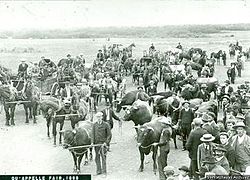
- school plays and concerts at Christmas and in the spring,
- amateur community concerts and theatricals in the "opera house" in the Town Hall;
- cricket matches and later, as the English constituency waned,
- community baseball games
- hockey games in the indoor community rink.
The town's churches mounted parish, congregational, Sunday School and other events through the year which were a focus of social activity for members of the four religious denominations of the town: the Church of England
Anglican Church of Canada
The Anglican Church of Canada is the Province of the Anglican Communion in Canada. The official French name is l'Église Anglicane du Canada. The ACC is the third largest church in Canada after the Roman Catholic Church and the United Church of Canada, consisting of 800,000 registered members...
, Roman Catholics, Presbyterian
Presbyterian Church in Canada
The Presbyterian Church in Canada is the name of a Protestant Christian church, of presbyterian and reformed theology and polity, serving in Canada under this name since 1875, although the United Church of Canada claimed the right to the name from 1925 to 1939...
s, Methodist
Methodist Church of Canada
The Methodist Church of Canada was a united church formed in 1884 and comprising most former Methodist denominations in Canada including some that had been active along Canada's eastern coast and north of the St...
s (later United Church
United Church of Canada
The United Church of Canada is a Protestant Christian denomination in Canada. It is the largest Protestant church and, after the Roman Catholic Church, the second-largest Christian church in Canada...
, containing all the Methodists and the majority of the Presbyterians) and, after the 1925 church
United Church of Canada
The United Church of Canada is a Protestant Christian denomination in Canada. It is the largest Protestant church and, after the Roman Catholic Church, the second-largest Christian church in Canada...
union, the continuing Presbyterian congregation.
There was also a cinema on Main Street which ceased to be viable with the arrival of television in the 1950s. The building had a brief reprieve in the 1960s as a general store after the closure of Hamblin's and the Red & White store; it now stands empty.
Sports and recreation


A horseshoe
Horseshoes
Horseshoes is an outdoor game played between two people using four horseshoes and two throwing targets set in a sandbox area. The game is played by the players alternating turns tossing horseshoes at stakes in the ground, which are traditionally placed 40 feet apart...
pitch was set up alongside the theatre. A curling club and curling rink were established in the late 1880s.
Within the town of Qu'Appelle, the Recreation and Culture Committee oversees the activities at the skating rink, Centennial and Capital Day Parks, Community Hall, tennis court and library. The Mclean
Mclean, Saskatchewan
-External links:********-Footnotes:...
Recreation Site 17 km (11 mi) west of Qu'Appelle to the west has a picnic area;
B-Say-Tah Point on Echo Lake, Valley Centre Recreation Site (29 km or 18 mi) also on Echo Lake at Fort Qu'Appelle, Sandy Beach and Katepwa
Katepwa, Saskatchewan
The Resort Village of Katepwa operates as the centre of the District of Katepwa, which includes many of the cottages that can be found along Katepwa Lake in . The Resort Village is home to a Hotel and Restaurant, cottages and log cabins to rent, and a general store just off the beach, complete...
Point Provincial Park 27.2 kilometres (16.9 mi) on Katepwa Lake, Lebret Recreation Site 29 kilometres (18 mi) on Mission Lake and Echo Valley Provincial Park 30 kilometres (18.6 mi) on Pasqua Lake are in the Qu'Appelle Valley; Katepwa Point Provincial Park features a picnic area, beach, nine-hole golf course, miniature golf course, fishing, boating and campground. This popular beach is located on Katepwa Road
Saskatchewan Highway 56
Highway 56 is a highway in the Canadian province of Saskatchewan. It runs from Highway 1 near Indian Head to Highway 210 within the Echo Valley Provincial Park. Highway 56 is about 57 km long....
.
Mission Ridge on Mission Lake is a winter ski resort.
Transport

Prince Albert, Saskatchewan
Prince Albert is the third-largest city in Saskatchewan, Canada. It is situated in the centre of the province on the banks of the North Saskatchewan River. The city is known as the "Gateway to the North" because it is the last major centre along the route to the resources of northern Saskatchewan...
trail served freight and stagecoach transport to the north-west and onwards to Edmonton
Edmonton
Edmonton is the capital of the Canadian province of Alberta and is the province's second-largest city. Edmonton is located on the North Saskatchewan River and is the centre of the Edmonton Capital Region, which is surrounded by the central region of the province.The city and its census...
.
The CPR formerly provided passenger service east and west from Qu'Appelle and generally throughout the province.
Early bishops of Qu'Appelle were able to travel by train from their see city of Qu'Appelle to parishes throughout southern Saskatchewan. CPR passenger services were heavily used before the arrival of widespread private motor vehicle ownership and again during the Depression; the CPR continues to run past Qu'Appelle but no longer maintains a station or passenger facilities; nor are there any longer grain elevators.

Highway 35
Saskatchewan Highway 35
Highway 35 is a paved undivided provincial highway in the Canadian province of Saskatchewan. It runs from the US Border near Port of Oungre to a dead end near the north shore of Tobin Lake. Saskatchewan Highway 35 SK Hwy 35) is about long. The CanAm Highway comprises Saskatchewan Highways 35,...
runs south to Weyburn unpaved and north to Fort Qu'Appelle; while no longer heavily trafficked since the opening of Highway 10
Saskatchewan Highway 10
Highway 10 is a provincial paved undivided highway in the Canadian province of Saskatchewan. It runs from Highway 1 near Balgonie until it transitions into PTH 5 at the Manitoba border. Highway 10 is about 228 km long....
from Balgonie to the Valley, it is still paved on the northward sector, although with the drastically depleted population it is inevitably falling into disrepair.
Utilities
Qu'Appelle was home to a North-West Mounted Police barracks established by Major Walsh in 1882. and until the 1950s there was a resident RCMP town constable. Early water was supplied by digging wells 10 to- deep, until the 1930s when a 300 feet (91.4 m) well was dug.. 1962 saw the construction of a 500-gallon (2250 l) water tower as well as the first town fire hydrant..The town foreman co-ordinates and manages the Public Works & Utilities Department. Qu'Appelle and the surrounding rural municipality
Rural municipality
A rural municipality, often abbreviated RM, is a form of municipality in the Canadian provinces of Manitoba and Saskatchewan, perhaps best comparable to counties or townships in the western United States...
of South Qu'Appelle No. 157 are served by the Qu'Appelle Volunteer Fire Department, who are trained in health care and fire rescue practices. Today the Indian Head RCMP
Royal Canadian Mounted Police
The Royal Canadian Mounted Police , literally ‘Royal Gendarmerie of Canada’; colloquially known as The Mounties, and internally as ‘The Force’) is the national police force of Canada, and one of the most recognized of its kind in the world. It is unique in the world as a national, federal,...
detachment provides police protection for the community.
Healthcare
Nowadays of course the population is far too thin to demand the services that were readily provided in past years. The town had a medical doctor living in the town from the early 1880s until the mid-1960s and for many years virtually all town and hinterland births occurred in Qu'Appelle Memorial Hospital, which opened on March 3, 1946 and closed March 1, 1969.. Diphtheria, smallpox, measles, scarlet fever and typhoid fever were early epidemics to hit the town.. Midwives were employed in childbirth deliveries.The Regina Qu'Appelle Regional Health Authority assesses and provides health care within the Regina-Qu'Appelle region. Regina
Regina, Saskatchewan
Regina is the capital city of the Canadian province of Saskatchewan. The city is the second-largest in the province and a cultural and commercial centre for southern Saskatchewan. It is governed by Regina City Council. Regina is the cathedral city of the Roman Catholic and Romanian Orthodox...
and Indian Head
Indian Head, Saskatchewan
Indian Head is a town in southeast Saskatchewan, Canada, east of Regina. The town is directly north of the Trans-Canada Highway. The town is known for its federally-operated Prairie Farm Rehabilitation Administration experimental farm and tree nursery that produces seedlings for shelter...
both have hospitals and special care homes in the Regina Qu'Appelle Regional Health Authority region which are near to Qu'Appelle. Fort Qu'Appelle
Fort Qu'Appelle, Saskatchewan
These figures do not include the substantial population living along the shores of the Fishing Lakes.-Origins:The current site is the third Fort Qu'Appelle. The first was a North West Company trading post , also in the valley but near what is now the Saskatchewan-Manitoba border...
is home to the Fort Qu'Appelle Community Health Services Centre, All Nations' Healing Hospital and the Echo Lodge Special Care Home.
Notable people from Qu'Appelle
- Vernon BarfordVernon BarfordVernon West Barford was an English photographer, musician, organist, choirmaster and teacher. Barford, nicknamed "Man of Many Talents," was born in Crowthorne in Berkshire, England. He began piano lessons at four and attended the choir school of Worcester Cathedral from 1887-92...
, (10 September 1876 - 22 April 1963) organist, choirmaster, teacher homesteaded and organist in the Qu'Appelle district between 1895 and 1900. - George H. V. BulyeaGeorge H. V. BulyeaGeorge Hedley Vicars Bulyea was a Canadian politician and the first Lieutenant-Governor of Alberta. As the youngest ever Lieutenant-Governor, at age 46, he was appointed by Governor General Lord Earl Grey on advice of The Right Honourable Prime Minister of Canada Sir Wilfrid Laurier on September...
, Canadian politicianPoliticianA politician, political leader, or political figure is an individual who is involved in influencing public policy and decision making...
moved to Qu'Appelle, District of AssiniboiaAssiniboiaAssiniboia refers to a number of different locations and administrative jurisdictions in Canada. The name is taken from the Assiniboine First Nation.- District of Assiniboia:...
, North-West Territories in 1893. Here he engaged in the furnitureFurnitureFurniture is the mass noun for the movable objects intended to support various human activities such as seating and sleeping in beds, to hold objects at a convenient height for work using horizontal surfaces above the ground, or to store things...
, flourFlourFlour is a powder which is made by grinding cereal grains, other seeds or roots . It is the main ingredient of bread, which is a staple food for many cultures, making the availability of adequate supplies of flour a major economic and political issue at various times throughout history...
, and feedFodderFodder or animal feed is any agricultural foodstuff used specifically to feed domesticated livestock such as cattle, goats, sheep, horses, chickens and pigs. Most animal feed is from plants but some is of animal origin...
businessBusinessA business is an organization engaged in the trade of goods, services, or both to consumers. Businesses are predominant in capitalist economies, where most of them are privately owned and administered to earn profit to increase the wealth of their owners. Businesses may also be not-for-profit...
es until 1907. He wrote an official handbookHandbookA handbook is a type of reference work, or other collection of instructions, that is intended to provide ready reference .A handbook is sometimes referred to as a vade mecum or pocket reference that is intended to be carried at all times.Handbooks may deal with any topic, and are generally...
regarding the North-West Territories. In 1905, he was appointed the first Lieutenant Governor of AlbertaLieutenant Governor of AlbertaThe Lieutenant Governor of Alberta is the viceregal representative in Alberta of the Canadian monarch, Queen Elizabeth II, who operates distinctly within the province but is also shared equally with the nine other jurisdictions of Canada and resides predominantly in her oldest realm, the United...
. - Percival GordonPercival GordonPercival H. Gordon, OC was a Canadian lawyer and a Justice of the Saskatchewan Court of Appeal.Born in Qu'Appelle, Northwest Territories of Scottish immigrant parents, he graduated with a Bachelor of Arts degree from the University of Toronto in 1905 and a Masters degree in 1906...
, a judge of the Saskatchewan Court of Appeal, born and educated as to primary and high school in Qu'Appelle. - Group Captain Claude Hilton KeithClaude Hilton KeithGroup Captain Claude Hilton Keith was an early pioneer of air gunnery who played a central role in the preparation of the Royal Air Force for World War II. His work as Assistant Director of Armament Research and Development with responsibility for armament led to the establishment of the "Air...
(1891–1966), born in Qu'Appelle, was an early pioneer of air gunnery who played a central role in the preparation of the Royal Air Force for World War Two. His career ended prematurely after championing the rights of R.A.F personnel posted in Canada. - Doug Killoh, played with the Saskatchewan RoughridersSaskatchewan RoughridersThe Saskatchewan Roughriders are a Canadian Football League team based in Regina, Saskatchewan. They were founded in 1910. They play their home games at 2940 10th Avenue in Regina, which has been the team's home base for its entire history, even prior to the construction of Mosaic Stadium at Taylor...
- Edward RawlinsonEdward RawlinsonEdward A. Rawlinson, SOM was a Canadian businessman. Born in Qu'Appelle, Saskatchewan, Rawlinson became the youngest chartered accountant in Canada in 1934. During the Second World War he was manager of British Commonwealth Air Training Plan flying school in Prince Albert.In 1946 Rawlinson bought...
, (June 2, 1912–1992), born in Qu'Appelle showed leadership in broadcasting across several radio stations to Saskatchewan and was the youngest chartered accountant in Canada. - Neil Schell, actor was born 24 April 1957, in Qu'Appelle. He has starred in a variety of television series and movies such as most recently A Little Thing Called Murder (2006) and Cabin Pressure / Hijack'd (2006).

See also
- List of communities in Saskatchewan
- List of towns in Saskatchewan
- Anglican Diocese of Qu'AppelleAnglican Diocese of Qu'AppelleThe Diocese of Qu’Appelle in the Anglican Church of Canada lies in the southern third of the civil province of Saskatchewan and contains within its geographical boundaries some 50% of the province's population of one million.-History:...
- Anglican Church of CanadaAnglican Church of CanadaThe Anglican Church of Canada is the Province of the Anglican Communion in Canada. The official French name is l'Église Anglicane du Canada. The ACC is the third largest church in Canada after the Roman Catholic Church and the United Church of Canada, consisting of 800,000 registered members...
External links
- Postcard views of Qu'Appelle at the turn of the 20th century
- Saskatchewan Settlement Experience. Photos of early settlement, including in Qu'Appelle
- Qu’Appelle Opera House Edifice & Us
- Town of Qu'Appelle website
- Sask Biz - Qu'Appelle
- http://esask.uregina.ca/entry/quappelle.html Encyclopedia of Saskatchewan

